

















Supply chain disruption has always been one of the biggest risks for marine cargo insurance. And recent events have put brokers to the test.
Natural language processing is enabling insurers to automate many processes — reducing costs, speeding up claims handling and improving the customer experience.

Smart reinsurers are identifying major opportunities in the insurance value chain and partnering with insurtechs to develop innovative solutions.
How do you insure something with very little historical data, with a value that fluctuates wildly and that operates under great regulatory uncertainty?
As the global population ages, some life insurers are considering bespoke dementia insurance cover as a way to deal with changing demographics.
is published quarterly by Heads & Tales for the Australian and New Zealand Institute of Insurance and Finance (ANZIIF). Vol. 45 No. 4 ISSN 144-8505
GENERAL ENQUIRIES
(61 3) 9613 7200 Fax (61 3) 9642 4166 customerservice @anziif.com anziif.com
ANZIIF OFFICE
Level 18, 1 Nicholson Street, East Melbourne, VIC 3002 Australia (61 3) 9613 7200 @anziif.com
Account director
Account manager
Hannah Louey
Managing editor
Jo Davy

Tel (61 0) 490 091 713

Email jodavy@ hardiegrant.com
Editor Abigail Murison Subeditor
Helen Eva
Art direction & design
Dallas Budde and Kieran Medici
ADVERTISING ENQUIRIES
Nicole Prioste
Tel (61 0) 410 618 331 Email nicoleprioste @ hardiegrant.com
Rising sea levels — ‘Sea levels have always changed during our planet’s long history, but this is the first time entire cities have been in the way of the water.’
STUART
Freelance writer

Covering crypto — ‘The crypto ecosystem is often described as the Wild West of financial services ... insurers may continue to wait until they have more certainty.’
The Journal editor
Dementia insurance — ‘... Insurers will have to evolve products or launch new ones to help people mitigate emerging risks associated with older populations.’
Heads & Tales Private Bag 1600, South Yarra, VIC 3141 Australia Tel (61 3) 8520 6444
Web headsandtales.agency
No responsibility is accepted by ANZIIF or Heads & Tales for the accuracy of any statement or advice contained in the text or advertisements. The opinions expressed in the Journal are those of the authors, not ANZIIF, unless otherwise stated. ANZIIF accepts no responsibility for the accuracy of information in articles and advertisements in the Journal. Article submissions to the Journal by ANZIIF members and others are welcome. Articles are accepted for publication only on the condition that the authors give ANZIIF an irrevocable non-exclusive licence to publish the article and authorise ANZIIF to give permission for production of the article in whole or in part by other persons and organisations for educational and training purposes, as well as on ANZIIF websites.
© Heads & Tales Agency, 2022. All rights reserved.
Connect with ANZIIF via social media and anziif.com
Whether your clients are looking to insure a small commercial property or a large corporate CGU has it covered. Backed by of one of Australia’s largest general insurers, coupled a strong, sustainable approach to risk and long term stability, your clients can be confident that we have a commercial property solution that fits their needs.
Whether your clients are looking to insure a small commercial property or a large risk, CGU has it covered. Backed by of one of Australia’s largest general insurers, with a strong, sustainable approach to risk and long term stability, your clients confident that we have a commercial property solution that fits their needs.
Whether your clients are looking to insure a small commercial property or a large corporate risk, CGU has it covered. Backed by of one of Australia’s largest general insurers, coupled with a strong, sustainable approach to risk and long term stability, your clients can be confident that we have a commercial property solution that fits their needs.
For more information, contact your Broker Relationship Partner.
Whether your clients are looking to insure a small commercial property or a large corporate CGU has it covered. Backed by of one of Australia’s largest general insurers, coupled a strong, sustainable approach to risk and long term stability, your clients can be confident that we have a commercial property solution that fits their needs.
Whether your clients are looking to insure a small commercial property or a large risk, CGU has it covered. Backed by of one of Australia’s largest general insurers, with a strong, sustainable approach to risk and long term stability, your clients confident that we have a commercial property solution that fits their needs.
Whether your clients are looking to insure a small commercial property or a large corporate risk, CGU has it covered. Backed by of one of Australia’s largest general insurers, coupled with a strong, sustainable approach to risk and long term stability, your clients can be confident that we have a commercial property solution that fits their needs.
For more information, contact your Broker Relationship Partner.
For more information, contact your Broker Relationship Partner.
Whether your clients are looking to insure a small commercial property or a large corporate risk, CGU has it covered. Backed by of one of Australia’s largest general insurers, coupled with a strong, sustainable approach to risk and long term stability, your clients can be confident that we have a commercial property solution that fits their needs.
For more information, contact your Broker Relationship Partner.
For more information, contact your Broker Relationship Partner.
For more information, contact your Broker Relationship Partner.
For more information, contact your Broker Relationship Partner.
consider the Product Disclosure Statement and Target Market Determinations available from the product issuer, Insurance Australia Limited, 016 722, AFSL 227681, trading as CGU Insurance. This advice is general advice only and does not take into account a customer’s individual objectives, financial situation or needs (‘personal circumstances’).
consider the Product Disclosure Statement and Target Market Determinations available from the product issuer, Insurance Australia Limited, 016 722, AFSL 227681, trading as CGU Insurance. This advice is general advice only and does not take into account a customer’s individual objectives, financial situation or needs (‘personal circumstances’).
Always consider the Product Disclosure Statement and Target Market Determinations available from the product issuer, Insurance Australia Limited, ABN 11 000 016 722, AFSL 227681, trading as CGU Insurance. This advice is general advice only and does not take into account a customer’s individual objectives, financial situation or needs (‘personal circumstances’).
Always consider the Product Disclosure Statement and Target Market Determinations available from the product issuer, Insurance Australia Limited, ABN 11 000 016 722, AFSL 227681, trading as CGU Insurance. This advice is general advice only and does not take into account a customer’s individual objectives, financial situation or needs (‘personal circumstances’).
Always consider the Product Disclosure Statement and Target Market Determinations available from the product issuer, Insurance Australia ABN 11 000 016 722, AFSL 227681, trading as CGU Insurance. This advice is general advice only and does not take into account a customer’s objectives, financial situation or needs (‘personal circumstances’).
Always consider the Product Disclosure Statement and Target Market Determinations available from the product issuer, Insurance Australia ABN 11 000 016 722, AFSL 227681, trading as CGU Insurance. This advice is general advice only and does not take into account a customer’s objectives, financial situation or needs (‘personal circumstances’).
12 May | Adelaide Convention Centre
Rub shoulders with local industry professionals while raising vital funds to help the next generation at the 50th annual South Australian Charity Luncheon. Last year’s event raised more than $13,400 for Camp Quality, and in 2023, ANZIIF is delighted to be partnering with the Little Heroes Foundation, an organisation that supports children experiencing physical and mental illness. R Buy tickets
ANZIIF Fellow and compliance expert Paul Muir has helped to update Beyond Breaches, a short course that covers how insurers can navigate the complex landscape of revised industry codes of practice, new laws and regulations, and new reporting requirements. Participants will also learn how to identify incidents of noncompliance, take the required actions as soon as possible and minimise customer harm.
Hear the latest industry news, capitalise on new opportunities, identify emerging risks and network with industry peers at the New Zealand Business Breakfast in May. This annual event features some of the best minds in the industry, who will provide guidance and advice in the rapidly changing insurance industry landscape.


Just starting out in the insurance industry?
READ //


Renowned economist Nouriel Roubini earned the nickname Dr Doom for correctly forecasting the 2008 financial crisis, and now he’s back with another dire prediction. The world is headed towards economic catastrophe, Roubini says, unless we can address 10 ‘megathreats’ that range from climate change and supply chain blockages to renewed battles between global superpowers. Not exactly light reading for your summer holiday, but forewarned is forearmed in 2023.
Available now. Little, Brown and Company.
› 267 million people worldwide live on land that’s currently less than two metres above sea level.
› Insurers are heavily influencing change around sea-level-rise risk mitigation.

› Cutting-edge data and modelling are helping communities select the interventions most suitable for their area, and increasing awareness of the issue of sea-level rise.

Climate change is stretching the limits of coastal infrastructure, as rising sea levels threaten to engulf entire communities. So, how much water does the future hold and what are governments, individuals and insurers doing to find a solution?
Sea levels have changed dramatically throughout our planet’s history. The United Nations’ Intergovernmental Panel on Climate Change (IPCC) says that since the end of the last ice age, sea levels have risen around 120 metres. So, why are we concerned about a relatively small rise of another 55 to 200 centimetres — according to the IPCC — by the end of this century?
‘There was that 120-metre rise following on from the last ice age. Then, for the last 6,000 years, sea levels have remained relatively stable,’ says Dr Kathleen McInnes, senior research scientist at CSIRO.


‘The problem is that it’s in that small window — in that 6,000 years — humans settled, and they settled mainly in coastal zones.’
A 2021 paper published in Nature
Communications found that 267 million people worldwide currently live on land less than two metres above sea level.
‘The beginning of the Industrial Revolution saw sea levels once again beginning to rise, and the rise is human induced,’ McInnes says. ‘The concern now is that we can’t just pick up our things and move away from the coast. We’ve got very established, very vulnerable cities.’
Currently, sea levels are rising 3.6 millimetres annually, McInnes says. While this may seem inconsequential, the cumulative effects of rises year-on-year are felt intensely during particular events. Climate change and sea-level rise isn’t linear. Instead, as both temperatures and sea levels increase, they combine to create exponential growth in the incidence of storms (and related storm surges), higher tides and flooding. Storms and high tides can also coincide, further increasing the sea level for those periods.
‘These can be tidal extremes, storm surges or highwave events, and so on,’ McInnes says. ‘Also, the combination of sea-level rise with a riverine flood event combines to increase flooding in coastal areas.’


Inhabited areas that previously had low sea-level variability naturally built infrastructure around that small range, she explains. As sea levels rise, that infrastructure no longer does the job. Flood mitigation, then, becomes a matter of cost benefit. Is the village, town, suburb or city worth saving? In some places, seawalls have been the go-to solution to mitigate flood risk. However, as 50- and 100-year storm and flooding events occur much more frequently, our existing seawalls may no longer be fit for purpose.
For instance, seawalls protect 360 km of the Massachusetts coastline. Authorities anticipate a 25–36-centimetre sea-level rise in the region by 2050. If the area experiences a storm similar to the 2015 North American blizzard again, researchers say the seawalls would need to be at least 90 centimetres taller than they currently are to prevent flooding. This would mean that seawalls in some places would need to more than double in height. But what may appear to be a simple fix is anything but.
‘The engineering has to be different for the higher seawall,’ says Dr Peter Sousounis, vice president and director of Climate Change Research at Verisk Extreme Event Solutions. ‘There’s more pressure on the wall from the greater depth and volume of water. Increasing a seawall height from one to two metres isn’t just double the cost. It’s around a factor of 10 higher.’
‘The concern now is that we can’t just pick up our things and move away from the coast. We’ve got very established, very vulnerable cities.’
Climate-change and sea-level-rise modelling is informing some planning and construction decisions, to help future-proof new infrastructure and make it an acceptable insurance risk. Dr Jacqueline Balston, director of sustainability at the Institute of Public Works Engineering Australasia and director of Jacqueline Balston & Associates, says: ‘At Brisbane Airport, the recently opened new runway has been constructed 1.5 metres above the minimum regulatory requirements, which is great planning.’
Planning decisions like this need to be part of a broader strategy, addressing sea-level-rise risk for the whole region, Balston says. The IPCC report says with ‘high confidence’ that by 2150, it is likely sea levels will rise 1.5 metres over today’s levels. It’s also possible, but in the low likelihood range, that sea levels will rise five metres by this time.
‘Although the useful life of a runway at a major airport varies from 20 to 40 years — and we can potentially keep lifting it — other assets in the apron around it will also be affected as the sea rises,’ says Balston. ‘There will come a time when they need to be raised or protected by seawalls. At some point that becomes untenable. How do you connect stranded assets together if the water is rising all around them?’
Balston recalls a sea-level planning project her firm worked on in a small coastal town in South Australia that highlighted a similar issue. ‘There’s a seawall and there was discussion about raising it. Digital elevation modelling shows a little strip of higher land where several of the houses are sited,’ she says. ‘[Those houses] may be okay for the next 100 years, but the road leading to them won’t be — it will be more and more regularly submerged with rising tides.’ The project raised several major questions for the community.
The issue is even more pressing in parts of Asia, McInnes says, because many older cities were built on sedimentary ground that naturally subsides — plus, fresh water typically comes from pumped groundwater, further compounding the problem.
The city of Jakarta in Indonesia, for example, is sinking much faster than the sea around it is rising. This is one reason that a new capital called Nusantara is now being developed 1,300 kilometres away, on the island of Borneo.
‘We need to look at where the exposed risk is,’ says Dr Milan Simic, executive vice president and director of International Business Development at Verisk Insurance. ‘You can have a hazard in terms of sealevel rise, but if there is no insured property, it doesn’t matter from the insurance point of view.
‘In Indonesia, in terms of coastal areas that are heavily populated, we’re looking at Jakarta. It represents 60 to 70 per cent of insured exposure for all of Indonesia. That’s why Jakarta is more of an emphasis than some remote islands.’
Across the world, countries are using different natural and man-made methods of water management for sea and flood management.
Mangroves are trees that grow in saltwater, with tangled root systems that bind the soil.

• Where / Pacific islands, US, China, Hong Kong, India, Bangladesh, Vietnam, Mexico.
• Pros and cons / Mangrove forests reduce erosion and act as a barrier to waves and storm surge. However, rising sea levels stunt their growth, and they would need access to lower-lying ground in order to spread.
Coastal back dunes — sandy hills with sea grasses and other plant life — can act as a buffer between the surf and land, and prevent erosion.

• Where / US, New Zealand, Australia, Ireland, South Africa, UK.
• Pros and cons / Sand is often readily available, and plants make the back dunes stable. However, in some places there is no space for them: the back dunes have already been flattened and built on or paved.

Hard structures / embankments built along the shoreline to act as a physical barrier to high seas and storms.
• Where / New Zealand, Pacific islands, US, Canada, Australia, Netherlands, Pakistan.
• Pros and cons / While seawalls provide protection for shoreline property and infrastructure, they also deflect wave energy to neighbouring areas, and can cause more beach erosion.

A structure built perpendicular to the shore, to interrupt water flow and trap sediment. Often, there are a series of groynes close together on a coastline to widen the beach(es).
• Where / UK, US, Malaysia, Philippines, Australia.
• Pros and cons / Groynes can prevent beach erosion, but have to be very well designed to operate as intended — with no water passing on the land side.
The same is true, Simic says, for heavily populated eastern seaboard cities in China and coastal cities in Australia and the United States, particularly lowlying Miami.
Some communities are building seawalls and surge barriers. Some are reconsidering building design — the classic Queenslander house designed on stilts, McInnes says, was an excellent design for its environment until homeowners began filling in the downstairs area to extend.
Others such as Singapore, where 30 per cent of land is less than five metres above sea level, are advancing into the sea, reclaiming land that is underwater and building it higher. Singapore is also creating nature-based buffer zones. These include urban green spaces along riverbanks and restored wetland ecosystems, rather than concrete water-management infrastructure.
In Australia, where 3.5 per cent of dwellings fall under the international definition of high risk, permeable pavements and green rooftops are being trialled.
In New Zealand, where 17,600 homes are under threat in Auckland alone, there is growing public support for some form of financial assistance for the relocation of communities from low-lying areas. And in Germany, researchers are working on selferecting flood protection systems that sandwich a buoyant, foam-type material between two layers of concrete. In everyday use it operates as a footpath or road. In flood environments it floats upwards, rotating around a hinge to form a waterproof wall.
The potential solutions are flowing thick and fast, but judging by the increasing number of floods, beach erosion and storm surge events, so is the water.
Insurers are considered part of the solution. Leading firms have been tracking the likely effects of global warming since long before it hit the headlines.
‘Twenty years ago, I saw a presentation by a speaker from Munich Re talking about climatic and geological hazards,’ says Balston. ‘The data went right back to the volcanic eruption of Mount Vesuvius in AD79, which is incredible. It was clear that although geological events had not increased in frequency, climate-driven ones had.’
The role of insurers in the fight against rising sea levels can be classified into four main categories:
1. Providing access to flood insurance
2. Increasing awareness of the risks of sea-level rise to individual assets
3. Developing risk responses with communities and authorities
4. Investing in technology and other interventions to mitigate flood and climate-change risk.
For example, in markets as disparate as the US and India, insurers are addressing the immediate need for access to insurance cover. In India, farmers can buy low-cost index-based flood insurance that has been developed with the help of satellite imagery. The International Water Management Institute is working with two insurers — Green Delta and WRMS — to provide cover to farmers in India and Bangladesh. The insurance is also bundled with a supply of moisture-tolerant seeds, which have a better chance of surviving heavy rains and flooding. In the US, many homeowners rely on outdated flood risk assessments from the Federal Emergency Management Agency and may have little or no insurance. As flood events became more common, Neptune Flood Insurance was launched to make it easier and faster to buy private flood insurance online. The brand promises you can get cover in ‘two minutes or less’ and has a partnership with satellite imagery company ICEYE to monitor water depth changes close to insured properties in real time, when flooding occurs.
Insurers are raising awareness of sea-level and flooding risks by sharing their own data and modelling with individuals, communities and authorities. In New Zealand, for instance, some property owners get a flood risk rating for their property (see page 12). In South Australia, the Local Government Association Mutual Liability Scheme requires each of the councils it works with to conduct a climate-change risk assessment process, and implement mitigation activities to address the risks detected.
‘The engineering has to be different for the higher seawall. There’s more pressure on the wall from the greater depth and volume of water. ’


‘Twenty years ago, I saw a presentation by a speaker from Munich Re talking about climatic and geological hazards … It was clear that although geological events had not increased in frequency, climate-driven ones had.’
Ron Mudaliar, Tower’s chief underwriting officer, reveals
insurer
In New Zealand, Tower Insurance has introduced a ratings system that measures how flood- or fire-prone a home is. Each customer receives a red (high risk), amber (medium risk) or green (low risk) rating, which is then reflected in the insurance premium they pay.
Says Mudaliar: ‘Lack of insurance cover is not a good result for anybody. Success is about identifying issues and figuring out how we mitigate them, for continuance of cover. We’ve been working with Treasury and with other government departments on that. We talked to them about our risk-based pricing for flood before we actually went out and deployed it.’
He says people need to understand how their properties are affected by flood and/or earthquake risk.
‘It’s not easy for homeowners to understand the wider risk and perils, such as flood and earthquake, linked to their home. We wanted to change that. We developed a tool that better matches premiums to individual risk, with homes with lower flood or earthquake risk, or that had mitigated risk through work done on the property or work done in the region by the local government, receiving reductions in the flood and earthquake portions of their premiums.’
Tower estimated that around 90 per cent of customers would see a small reduction in their premium costs, while around 10 per cent would see modest premium increases.
‘Through our work with Treasury, we’ve been part of the national adaptation planning,’ says Mudaliar, ‘and through our development of the detailed modelling tool, we’re improving transparency and understanding of risk at an individual householder level.’
‘The Insurance Council of Australia has been co-operating on projects with South Australian councils to identify climate change risks to infrastructure,’ says Balston, ‘so there’s a lot of valuable information being shared and a lot of work being done to work out how to best to tackle the problem.’
Sharing data allows communities to develop the best possible response to sea-level rise in their area, whether that’s a natural barrier like wetlands and mangroves or man-made intervention, including levees and seawalls. Managed retreat – where communities accept that at some point certain homes and infrastructure may need to be abandoned completely – may also be a consideration.
Insurers play a major role in influencing change, McInnes says, even simply by refusing to insure properties for certain risks in specific areas.
‘They’re not necessarily saying you can’t live here anymore,’ she says. ‘They’re saying if you want to build here, let’s get some really good design principles into houses. Certainly, in the UK, the insurance industry was quite involved in funding research to ensure people had good access to innovative design.’
Lastly, insurers have the investment clout to make a difference by supporting the development of technologies and methods of mitigating flood risk and addressing the greater issue of climate change. Many insurers have already mapped out their own paths to net zero, and are actively investing in green tech, while phasing out support for coal and oil.
Says McInnes: ‘There are numerous ways that insurers become one part of the solution, and their role will only become more important over the next few decades.’
CHRIS SHEEDY Freelance writer‘Sea levels have always changed during our planet’s long history, but this is the first time entire cities have been in the way of the water. A number of mitigation strategies and innovations, many fuelled by insurance data and funding, are now being unleashed.’

‘There are numerous ways that insurers become one part of the solution, and their role will only become more important over the next few decades.’
Dr Kathleen McInnes / CSRIO
the lengths the
has gone to in helping create solutions to challenges presented by sea-level rise.
Insurance Advisernet New Zealand are proud and humbled to be named Network of the Year at the recent 2022 ANZIIF Awards. Thank you to all the hard-working people in our broker network – 70 incredible locations throughout the country – who have stood by their clients through the hard times and the good this year. This win is yours. We’d also like to acknowledge Sherpa Insurance Brokers & Advocates who won the SmallMedium Broking Company of the Year category. This team consistantly goes from strength to strength. We’re so pleased for you and it’s fantastic to have you on our team.

Bring on 2023!
Call 0800 524 760 or visit insuranceadvisernet.co.nz to find out more.
by Lachlan Colquhoun Illustrations by Cami
In the third decade of the 21st century, it seems that if you own or lease an asset, you can share it — most often on a digital platform. The groundbreaking business models of Airbnb and Uber were only the start of a worldwide phenomenon that has taken different forms in different markets.
In the accommodation market, Vietnam has Luxstay and New Zealand has Bookabach. Anyone wanting to rent a car space in Australia can go to Oscar, or work from a temporary office with Spacely. In Malaysia, Grab provides ride sharing, car share and food, grocery and courier deliveries, and Gojek does the same in Indonesia and other South-East Asian countries. And in micromobility, e-scooter rental business Neuron began in Singapore in 2016 and is now operating in Australia, New Zealand, the United Kingdom and Canada.
In the United States, the hot summer has been a boost for Swimply, a platform where people can rent out their swimming pool by the hour. For those who like a bigger expanse of water, there’s boating rental marketplace Boatsetter, which has experienced 47 per cent 12-month growth. There’s even a platform called Wardrobe, where people can rent out their clothes.
› The sharing economy creates grey areas for insurance, because blurred lines of responsibility mean the apportioning of risk is more complex. Personal insurance policies will often not respond if someone rents out an asset for commercial returns.
› Insurers have responded with standalone insurance cover, pay-per-kilometre / minute insurance, and platform cover — among other innovations.
Andrew Wong / KOBA‘The world is moving on with mobility and rideshare, and insurance products are just not keeping up with the pace.’
Founded 10 years ago, Boatsetter is now one of the fastest-growing sharing platforms in the United States.

Jaclyn Baumgarten, co-founder of Boatsetter, told US news website Axios that the number-one challenge she had to solve was insurance.
She says most recreational boat insurance is voided if the owner rents out their vessel.
The Boatsetter insurance policy is underwritten by GEICO Marine Insurance and designed as a standalone recreational boat insurance policy, covering the time the boat is being rented. It is available for all non-commercially insured boats.
Depending on the circumstances, the insurance covers owners, hirers and guests. The policy offers coverage of US$300,000 per person and US$1 million total liability per accident.
What all these platforms have in common is that the owner of the asset temporarily gives up use and control of it for a designated period. What is different to the longstanding hire car industry, for example, is that there are multiple parties involved.
Where a hire car company offers insurance options to customers in a direct relationship, in the sharing economy there are at least three parties: the platform, the asset owner and the hirer. This new model has created significant grey areas for insurance as well as blurred lines of responsibility and apportioning of risk.
If you rent someone’s swimming pool through a platform, for example, and one of your children’s friends comes along to play and is injured, who should bear the responsibility — you, the owner of the pool or the platform provider?
Swimply’s solutions is to offer two programs built into rental costs and platform commissions. One is designed to protect hosts and the other protects guests. Its host liability insurance covers hosts by up to US$1 million if a guest is injured during a reservation and files a claim or lawsuit.
Stuart
This also covers defence costs for disputes in which both Swimply and hosts are legally liable and covers hosts in instances not covered by their home insurance.
There is also property damage protection. If guests inflict damage during a reservation, hosts are eligible for up to US$10,000 if their pool is damaged and the guest is unwilling to pay for repairs.
This might not seem too different from traditional insurance models, but one company offering a new model is Australian car insurance start-up KOBA. The company’s core product is pay-by-the-kilometre car insurance, calculated through connecting a sensor to the telemetric systems in the vehicle.
KOBA founder Andrew Wong explains that KOBA is moving into the sharing economy through a partnership with fellow start-up Car Next Door, a platform with 360,000 members where people can rent out their vehicles when they are not using them.
‘Car Next Door had a problem in that when you rent a car on the platform, the owners are responsible for their own insurance, and they are
responsible for telling their insurers they are using their cars for commercial purposes,’ says Wong.
‘This is a grey area in some product disclosure statements and not others. We called up a couple of major insurers about three or four times and they gave us a different answer each time on whether you were allowed to use car share.
‘The world is moving on with mobility and rideshare, and insurance products are just not keeping up with the pace, so we are using our tech and the Car Next Door tech and putting our solution into their booking system.’
The KOBA solution uses the sensor device and works with Car Next Door’s Instant Keys GPS device to understand the moment the borrower takes control of the car and when they relinquish control back to the owner.
The hiring cost includes an insurance component that covers the hirer in the event that they damage the car or are involved in an accident with a third party. ‘The technology gives us total clarity on who is responsible, so there are no grey areas,’ says Wong. ‘When the owner gets the car back, coverage reverts to them.’
Wong says many people who make their cars available through Car Next Door do so as a sideline business and rarely, if ever, drive their cars themselves. These are people who also benefit through KOBA’s core product, where customers pay a flat fee to cover any damage to the vehicle when it is unused and stationary, and then pay by the month for any kilometres they may drive themselves.
Global insurance broker and sharing economy specialist Marsh has also put time into helping clients navigate the complexities of the sharing economy and its risk and insurance implications.

The company published a 2021 white paper, Mobility in a post-pandemic world, where one of the key tenets was that successful businesses in the sharing economy would not ‘look at risk and insurance as a “top-three cost” but as an opportunity to build trust and gain competitive advantage’.
Dimitri Hursalas, the national segment leader for the sharing economy at Marsh in Sydney, says that while larger-scale, peer-to-peer (P2P) platforms such as Airbnb have created insurance coverage that protects all parties, smaller P2P
The next challenge on the horizon in the sharing economy will come when autonomous vehicles become commonplace, and if — as predicted — owners rent them out to others. This introduces yet another participant into the risk landscape: in addition to the sharing platform, asset owner and hirer, there is also the driverless car manufacturer.
In May 2022, Marsh participated in the pilot of an insurance solution in Europe, teaming up with sharing economy insurance specialists Apollo ibott and Aioi Nissay Dowa Europe to create an insurance solution for a driverless vehicle journey in the United Kingdom.
The insurers worked with driverless software company Oxbotica, whose solutions were deployed in the allelectric Applied EV vehicle that conducted the journey.
The ‘zero occupancy’ insurance solution is the first of its kind in the UK and is tailored specifically for the risks associated with L4 (high automation) vehicles on open roads.
sharing ‘of household items or things like tools or photography equipment’ presents greater challenges and is driving product evolution. Further, compared with traditional models based on historical data from customers, the sharing economy makes it difficult for insurers to price risk, says Hursalas. The need to understand the sharing economy better, he adds, is yet another driver for the insurance industry’s appetite for data as it seeks to understand new sets of metrics.
Marsh takes a two-pronged approach to helping facilitate the insurance market in this area. ‘In micromobility, we work with insurers to develop policies that are rated on a metrics basis, such as minute per trip, delivery per ride, and we try to write a policy that responds to how their business operates and also how the risk apportions out,’ says Hursalas. ‘Ultimately, in these situations it is a hierarchy and participants are always responsible for their own liability.’
Marsh is largely factoring its sharing model insights into the corporate insurance taken out by the overarching client, such as the platform, which then factors risk and responsibility into its users as it sets charges.
This might not be as headline grabbing as KOBA’s connected device, but Hursalas says the approach is still significantly ahead of previous practice.
‘Look at the old holiday bike-share model,’ he says. ‘By and large, you had no coverage as a person riding that bike, but the organisations coming into this micromobility space understand the risk, and they look to address that in a fashion which encourages good behaviours.
‘At the same time, it’s up to them to make sure that if an incident occurs, then there is no party in the incident who is left worse off.’
‘Our family is thinking of renting out our home on Airbnb. This story had me looking at the fine print of our household insurance policy and at the policy on Airbnb and on other platforms. It’s not as simple as it looks. Before we go ahead, we’ll be looking much closer at balancing all the potential risks against the returns. I’m determined not to leave any loopholes, either for ourselves or for our guests.’
Newly appointed ANZIIF board member Brendan Dunne is looking forward to exploring how the leading insurance membership and learning organisation can contribute to raising industry standards.
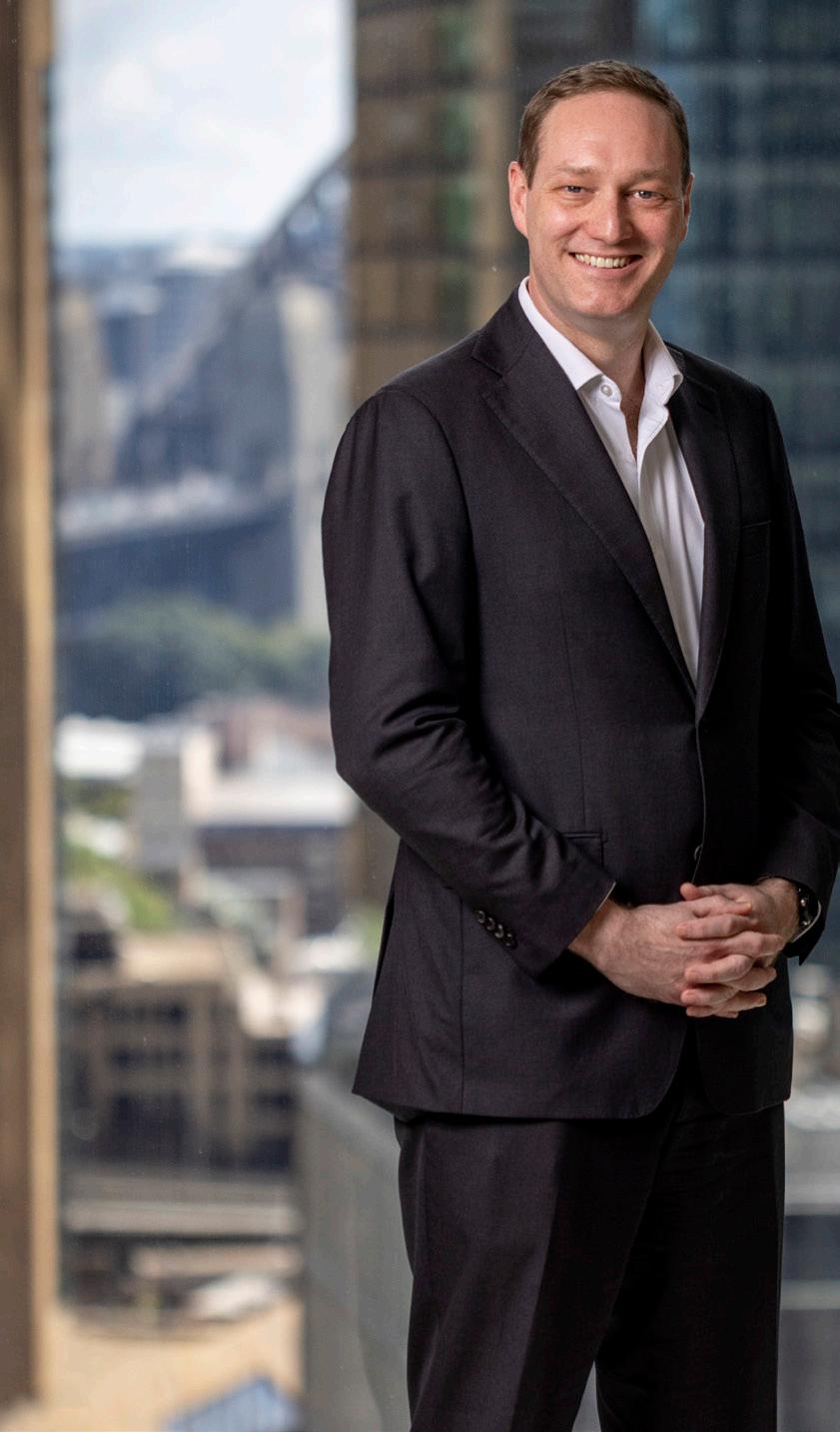
rendan Dunne and his team at Allianz Australia have set their sights on creating an industry benchmark for implementing change that results in exemplary services for both customers and people. Dunne, the company’s chief customer and operations officer, is a strong believer in having the customer experience inform the design of systems and processes. ‘Our technology and project teams have placed a lot of emphasis on this approach to devising solutions that are intuitive and deliver a seamless experience,’ says Dunne, who was recently appointed to the ANZIIF board.
‘We strive to make insurance simple for our customers and our people by simplifying our products and processes.’
Having worked for Allianz for nearly 20 years, Dunne says consistently delivering that experience will always be a challenge.
‘That’s why I believe simplicity is so important — it’s a way to reduce the number of opportunities for a process to go off track,’ he says. ‘We also recognise that customer expectations will continue to develop, and responding to those changing needs is a real motivator in my role.
‘Empowering employees to improve customer satisfaction in new ways is extremely important. Feedback along the way is a key part of the process to continue learning and growing — whether from customers or internal stakeholders.’
Born and raised near Gosford on the Central Coast of New South Wales, Dunne moved to Sydney to complete his accounting degree, which included two six-month placements in industry, one of which was with Allianz Australia.

He later joined Allianz as part of its highly soughtafter graduate program in a finance role he thought a natural fit.
‘Allianz has a presence in over 85 countries, so the variety of roles and international opportunities at the company has always been popular with graduates, and that was true for me at the time,’ Dunne recalls.
‘For me, it meant the chance to spend time overseas working in our global head office before moving into roles outside finance.’
Dunne says he always had an interest in the company’s business side, and his technical background in finance provided a platform to move into roles where he could leverage his skills and learn new ones.
‘Allianz recognised my appetite for a challenge, which led to opportunities to move into different areas of the business. I’ve tried to explore roles that stretch my leadership capacity and provide a chance to develop my knowledge and experience.’
Notwithstanding his ambitions, Dunne is a firm believer in people and teams as a company’s ‘greatest asset for delivering for customers’.
‘My team plays an important role in delivering Allianz’s purpose to secure the future of our customers,’ he says. ‘The frontline claims teams in my division are key — providing support when our customers need it most.’
Despite the move to increasing digitalisation of service delivery, it’s people who play a huge part in how those services are designed and built, says Dunne. ‘We still need people to provide care and empathy to customers,’ he adds. ‘Getting this right is based on having the right culture in place — a customerfirst approach.’
While innovation is often seen through the lens of technology, Dunne says he’s ‘incredibly proud’ of Allianz’s commitment to thinking outside the box.
For example, during the COVID-19 pandemic, global lockdowns caused a backlog in the company’s claims processing. As a solution, Allianz embarked on an industry-first partnership with Jigsaw, an organisation that provides training and employment opportunities for people with disabilities.
‘We initially hired four young adults to assist with our backlog,’ Dunne says. ‘They did an outstanding job of reducing the backlog in a matter of weeks.’
The partnership with Jigsaw is an ongoing win–win situation. ‘We’ve built a strong relationship with Jigsaw and have since expanded the program to 37 team members across three of our offices,’ says Dunne.
Dunne also points to Allianz’s management of the recent flood catastrophes in Australia.
‘We had a presence on the ground through field offices with senior leadership and frontline staff rotating onsite,’ he says, ‘so I had the privilege of visiting our field office and meeting with some of our customers. I stood in their homes, heard their stories and witnessed the great work our people and partners were doing.’
For Dunne, trust is a big part of leadership, and he likes to understand a person’s ‘why’.
‘There are often very different motivators for people in their work, and I find that the leadership approach needs to be flexible in its response,’ he says. ‘The values I regard highly include being passionate about the business, the customer and being part of a team.’
He is grateful for the support and guidance of many people locally and globally, some of whom were there from the early stages of his career.
‘Over that time, people have invested in me and they have been there with me as I moved through the organisation,’ he says. ‘There is real trust in those relationships, which is invaluable when I need a different perspective or guidance.’
As the executive sponsor for Allianz Australia’s Pride Network, Dunne firmly believes in the critical role
of diversity and inclusion in fostering the desired company culture. ‘Feeling a sense of belonging is a big part of being able to perform at work, and all employees need to be comfortable bringing their whole self to achieve that,’ he says.

Dunne would like to see his teams continue their focus on attracting and retaining the best talent in the industry by making Allianz a great place to work.
‘We are investing in the expansion of our Technical Claims Academy to continue building the capabilities and professional standards of our people,’ he says. ‘In addition, investing in learning for our people and our leaders is a priority. We have an internal commitment for all our people to complete 45 hours of learning and development each year.’
Dunne also spends a significant portion of his role defining what binds different parts of the Allianz business together. ‘It’s critical that we prevent the silo effect so that our collective sum is more powerful than the individual parts,’ he says.
As one of the latest recruits to the ANZIIF board, he is looking forward to exploring different perspectives on raising industry standards.
‘It’s a real privilege to be a member of the ANZIIF board,’ says Dunne. ‘To me, ANZIIF represents professional standards and education — two areas I am very passionate about.
‘I think many of us work in a default state of “busy” and that often means development is overlooked both for ourselves and our teams.’
Dunne asserts that professionalism is a great way for the insurance industry to shape how it is perceived by the community.
‘The technical nature of what we do is not always understood, so lifting our standards can only be a positive.’
‘I think many of us work in a default state of “busy” and that often means development is overlooked both for ourselves and our teams.’
Dunne grew up near Gosford on the Central Coast of NSW. He moved to Sydney to complete his accounting degree and then joined Allianz’s graduate program.
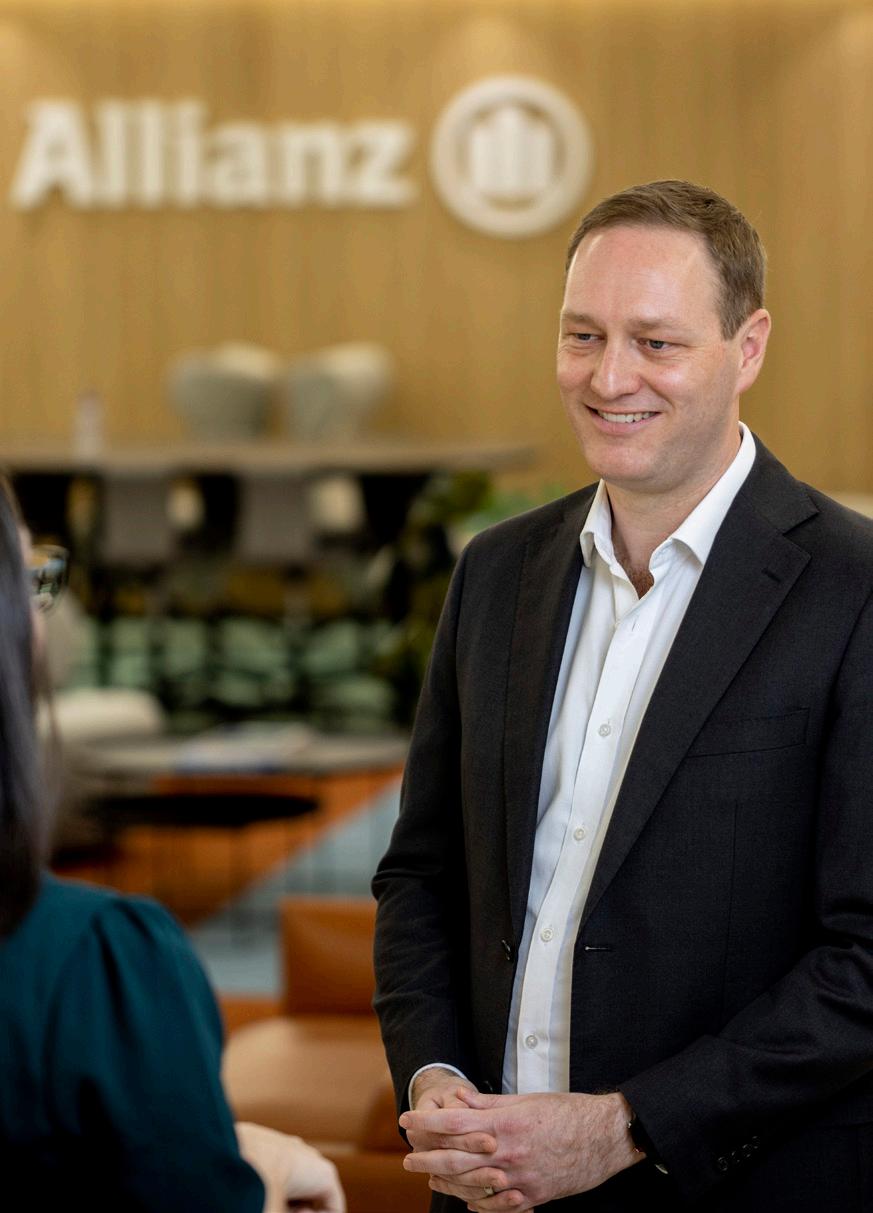
Dunne has been with Allianz for more than 19 years with senior roles across finance, risk, strategy and transformation. He was appointed chief customer and operations officer in April 2021.
Dunne has a three-year-old son, who keeps him busy outside work. Taking his dog MacGyver for walks helps him keep his step count up. ‘I always feel better when I’ve been active, and it balances out my other interests of food and wine.’ Dunne also volunteers with the B Miles Women’s Foundation, an organisation that helps women who are homeless or at risk of homelessness. ‘I find working with B Miles requires a different mindset and opens me up to different perspectives that put other work challenges in context,’ he says.
‘Embrace opportunities. If customers are your passion, then spend some time in a role that is close to the customer. While there are plenty of technical skills to develop, there is nothing like that frontline experience of hearing from the customer directly. Broaden your skillset to include customer experience design techniques, understand customer data and use prototypes and customer testing. One of my stand-out experiences at Allianz was taking a prototype system design we had developed out on to the streets of Sydney to get feedback from customers.’
› As tech solutions become commonplace, insurance professionals in all areas need to improve their data literacy.
› With artificial intelligence serving up relevant facts and information, soft skills such as empathy will become more important for insurance representatives.
› Coding and programming are important data analysis skills, as they are needed to retrieve specific information from datasets.
Insurance has always been underpinned by effective data analysis. However, technology harnessing big data, artificial intelligence (AI) and machine learning now has more practical applications in business than ever before. While data skills might once have been essential for actuaries and underwriters alone, data literacy — being able to read, write, analyse and communicate data to others — is fast becoming a must-have skill for professionals in every area of insurance.
‘The exploding volume of data available to insurance carriers is giving rise to new business models, revenue streams and enormous opportunities to increase value,’ says Vikas Bhalla, executive vice president and head of insurance business at EXL. ‘The industry needs an infusion of technical skills, complemented by softer skills in areas such as customer engagement and empathy.’
In New Zealand, AA Insurance takes a multipronged approach to upskilling its teams to leverage data. This includes continuous career development opportunities, on-the-job training and one-on-one coaching and mentoring, as well as in-depth onboarding and inductions.
Pricing teams receive training in programming languages, and the insurer regularly updates the tools and software required to carry out pricing roles.
Conveniently, the ways to learn data-related skills have also become both more accessible and more affordable. Multiple online platforms and apps offer courses in coding, data analysis and specific data tools and programming languages such as Python and JavaScript.
AA Insurance uses an online platform called Udemy to upskill all its team members, and the company has found it to be flexible and effective. Company leaders are trained using a program called Elevate.
Learning organisations such as ANZIIF also offer a number of online courses to improve your data-related abilities, including skills units on analysing data, assessing risks and insurance market analysis.
That doesn’t mean all learning has to take place online; balancing out the need for data skills is the enduring demand for soft skills, such as emotional intelligence or EQ, and for the lessons that come from old-fashioned experience. At Old Mutual, CIO Johnson Idesoh is upskilling the workforce through two-way teaching.
Insurers have more data than ever before — now it’s time to learn how to use it. Experts weigh in on the technical and soft skills you need to make your mark in the information age.
In Ensuring enduring insurers, DXC Technology’s report on futureproofing the insurance industry, the authors highlight Old Mutual’s learning program for bringing together new joiners with people who have been in the company for more than 30 years and have deep familiarity with its business processes. The two have different skill sets and exchange tips and knowledge.
‘Companies can extend these individuals’ tenures, so they can play a significant role in helping new hires gain new skill sets in a smooth transition. We’ve seen this model work before in other industries, and it is successful,’ states the report.

‘The industry needs an infusion of technical skills, complemented by softer skills in areas such as customer engagement and empathy.’
Not sure where to start when it comes to improving your data literacy? Eliza Kirkby, regional director at recruitment and workforce solutions specialist Hays, and Chris Mitchell, head of data and analytics at AA Insurance, have some recommendations.


Coding involves pulling data from different sources and it often involves different coding languages. It is not a prerequisite skill, but a basic level of coding can help professionals who are working for insurers that are undergoing digital transformations, says Kirkby. She adds that the development of ‘no-code’ and ‘low-code’ systems can mean there is less of a need for coding in future. ‘[Coding and programming] are important data analysis skills to be able to determine the specific information you are trying to retrieve in datasets,’ says Mitchell. ‘When you have thousands of data points, these skills can help you successfully pull and interpret the data required.’
Codecademy: coding Sololearn: learn-to-code apps (Android and iOS)
Udemy: Python programming courses

Statistical analysis makes it possible to collect and analyse data to discover patterns and trends and effectively present the results. ‘Strong statistical analysis skills give you the ability to confidently say what is and isn’t working for the business,’ says Mitchell.
Kirkby says that employers value statistical analysis skills in employees because they are able to analyse data, identify patterns and draw conclusions — particularly in the claims assessment space.
‘While insurance firms often employ a dedicated data analyst, all insurance professionals can benefit from learning how to use and draw analysis from data — it’s certainly a skill that stands out on your CV,’ she says.
ANZIIF Skills Unit: Analyse data Udacity: Intro to statistics Apps: Probability Distributions (Android and iOS) and Data Science 101 (Android)
Kirkby believes that these are two of the most important skills for insurance professionals. They enable a person to assess a situation and find the best solution, such as determining the most appropriate cover or calculating risk.
‘Critical thinking helps you rationally review information from every angle, question assumptions then make informed decisions,’ she says.

Mitchell agrees, adding that to derive genuine value from data, it helps to have a naturally analytical mind. ‘Being able to draw appropriate conclusions by identifying what is relevant and spotting any trends is essential for providing good customer outcomes.’
ANZIIF Skills Unit: Analyse the insurance market Coursera: critical thinking courses Brain training apps: Lumosity (Android and iOS), Peak (Android and iOS) and Elevate (Android and iOS)
Data is valuable at every point of the value chain and should be part of a broader strategy to ensure that it is being used with the end goal of delivering benefits to customers, says Chris Mitchell, head of data and analytics at AA Insurance.
For example, data can be used in product design to generate ideas on new products, as well as provide valuable information that will determine whether a product is effectively addressing the needs of customers.
‘It can help inform what adjustments can be made to improve customer experience,’ says Mitchell.

This technology-driven approach is a far cry from times past, notes Dr Michael Neary, regional general manager, insurance, Asia Pacific, DXC Technology. ‘When I started in insurance, the focus was on trying to find the right bit of paper with the information you needed,’ he says. ‘Someone would be speaking to you [on the phone], but you’d be busy reading a manual or a manager’s handbook.’
Now, some insurance companies are using AI to analyse the content of a phone call and deliver the right information for a particular query. With the technology providing the facts and references, more important skills for insurance representatives to work on are active listening and EQ.
‘The insurance professional can focus on listening and identifying whether there’s anything else at play,’ says Neary.

‘For example, in workers compensation, often there is a primary physical injury for someone, but the reason the individual has not returned to work could be due to an underlying mental health condition, which has developed as a result of the injury and being on prolonged leave from work.
‘It’s about being very attuned to the person: building connection, trust and active listening.’
‘The insurance professional can focus on ... identifying whether there’s anything else at play. It’s about being very
to the
JESSICA MUDDITT Freelance business journalist
Insurance issued by QBE Insurance (Australia) Ltd. ABN 78 003 191 035, AFSL 239545. Subject to underwriting approval. Terms and conditions apply (including exclusions and limitations).
Insurance issued by QBE Insurance (Australia) Ltd. ABN 78 003 191 035, AFSL 239545. Subject to underwriting approval. Terms and conditions apply (including exclusions and limitations).
Welcome to QBE, where insurance isn’t just a one-off commercial transaction, it’s a dependable relationship that guides and protects us through life. It’s why businesses across Australia rely on our experience to cover what matters, before & after and every moment in between.
Welcome to QBE, where insurance isn’t just a one-off commercial transaction, it’s a dependable relationship that guides and protects us through life. It’s why businesses across Australia rely on our experience to cover what matters, before & after and every moment in between.
Find out more at qbe.com/au/brokers
Find out more at qbe.com/au/brokers
t can come as a surprise that a person whose career has been built on assessing risk would choose to live and work in Papua New Guinea, given its reputation for violent crime and natural disasters. But for Victoria Clifford, her appointment earlier this year as chief executive officer of PNG’s sole reinsurer, Pacific Re, is but the latest development in a career marked by bold and unexpected moves.
As she herself puts it: ‘Take chances on opportunities if and when they present. Never in years would I have thought I would be working and living in Papua New Guinea.’
Clifford’s path to a career in reinsurance was not altogether conventional. Despite being a Sydney local with no obvious connections to farming, when she finished secondary school Clifford chose to study agricultural economics at the University of Sydney. She confesses that, at the time, she knew little about the field but was attracted by the relatively small size of the faculty and promising job prospects.
The next leap of faith came at the end of her degree when she was looking at what to do next. One of the positions she applied for was the graduate program at reinsurer Munich Re. Before the interview she received some advice from a family friend who worked in finance about what reinsurance was.
‘Reinsurance was explained to me as just like a bookmaker offsetting a large bet with other bookmakers at the track [to reduce] his exposure,’ Clifford recalls. ‘I think I even used this explanation at one of the interviews. I am not sure if I would do that again today.’
Despite the betting analogy, Clifford impressed her interviewers enough that she was offered a place — an opportunity for which she has been grateful ever since.
She joined Munich Re’s graduate program in 1998 and over the next two years spent time in each of the main areas of the business, gaining insights and knowledge from highly experienced underwriters.

COMPANY // Pacific Re TITLE // CEO
A commitment to hard work and a willingness to try a different tack have led Victoria Clifford to Papua New Guinea — in the CEO chair at Pacific Re.

 STORY Adrian Rollins PHOTOGRAPHY Daniel Wala
STORY Adrian Rollins PHOTOGRAPHY Daniel Wala
Over the next 10 years, Clifford rose steadily through the organisation, drawing on her knowledge of agricultural economics and applying that in the world of reinsurance. By early 2008, she was plying her trade as an underwriter in Munich Re’s property, agricultural, marine treaty and facultative (reinsurance purchased for a single risk or a defined package of risks) portfolios.
In late 2009, Clifford moved to Great Lakes Australia, Munich Re’s direct insurance arm, and, after a year there, joined Allianz Australia as rural product manager.
In 2013, she took up an opportunity as senior underwriter — Property and Agricultural Treaty for Hannover Re’s Australian branch, a role she held for more than six years before establishing her own reinsurance consultancy, VAVC Business Solutions.
Throughout her career, Clifford says she has benefited greatly from the guidance of mentors — “strong, experienced females” who she could look up to.
‘Mentors have been an important part of my professional development, particularly in the early years working in a very male-dominated industry and companies,’ she says.
It was while working as a consultant to Pacific Re that Clifford learned about the CEO opportunity and decided to apply.
At the time, Pacific Re had just been acquired by the PNG Government-owned insurer Motor Vehicles Insurance Limited (MVIL) and, Clifford says, was suffering from under-investment.
MVIL has since injected capital into the business and is backing Clifford’s plans to build up the skills and development of staff. She has begun to run in-house training programs and is in discussions with ANZIIF about adapting some of its courses for use in PNG.
While altering an organisation’s culture can be a slow process, Clifford says Pacific Re’s staff have demonstrated a strong hunger for knowledge, and there has already been a noticeable change in understanding and attitude.
‘It has been really good to see staff buy-in. Everyone is stepping up,’ she says. ‘I have got underwriters doing things that they would never have thought they would. It is about giving people the opportunity to try something, like spending time with clients to get a better understanding of them and their needs.’
Clifford has found herself drawing on the underwriting skills she developed early on in her career.
‘For us, there isn’t the emphasis on rating models,’ she says. ‘It’s back to old-school underwriting, where underwriters need to have a good understanding of the risk, compared to inputting everything into a model and pressing a button to get the answer.
‘My personal view is that you end up with a better underwriter because of it.’
Clifford is clear-eyed about the challenges of her new work environment. Electricity is unreliable, internet connectivity can be intermittent, crime is a pervasive threat and advanced health care is offshore. She carefully considered issues such as personal security, medical support and how she might be received by people within the company and the broader business community before committing to the role.
But, after more than six months as Pacific Re CEO, Clifford is very pleased with her decision.
While security is an unavoidable part of living and working in PNG’s capital and power blackouts are a hassle, such concerns pale compared with the opportunities to undertake work that is challenging, varied and fulfilling.
‘Everyone has a certain perception of Papua New Guinea and some of that may be warranted. But it is not until you travel there that you see the real
‘For us, there isn’t the emphasis on rating models. It’s back to old-school underwriting, where underwriters need to have a good understanding of the risk ...’
Victoria Clifford grew up in Sydney and studied agricultural economics at the University of Sydney. She currently lives in Papua New Guinea’s capital, Port Moresby.
After completing her bachelor’s degree, Clifford joined Munich Re’s graduate program in 1998. She remained at Munich Re for the next 10 years, rising to underwriter before moving to Munich Re subsidiary Great Lakes Australia for a year. In 2010, Clifford joined Allianz Australia as rural product manager, and she moved to Hannover Re in 2013 as a senior underwriter. She stayed there for seven years and, in 2020, set up her own consultancy, VAVC Business Solutions. Clifford became CEO of Pacific Re in April 2022.
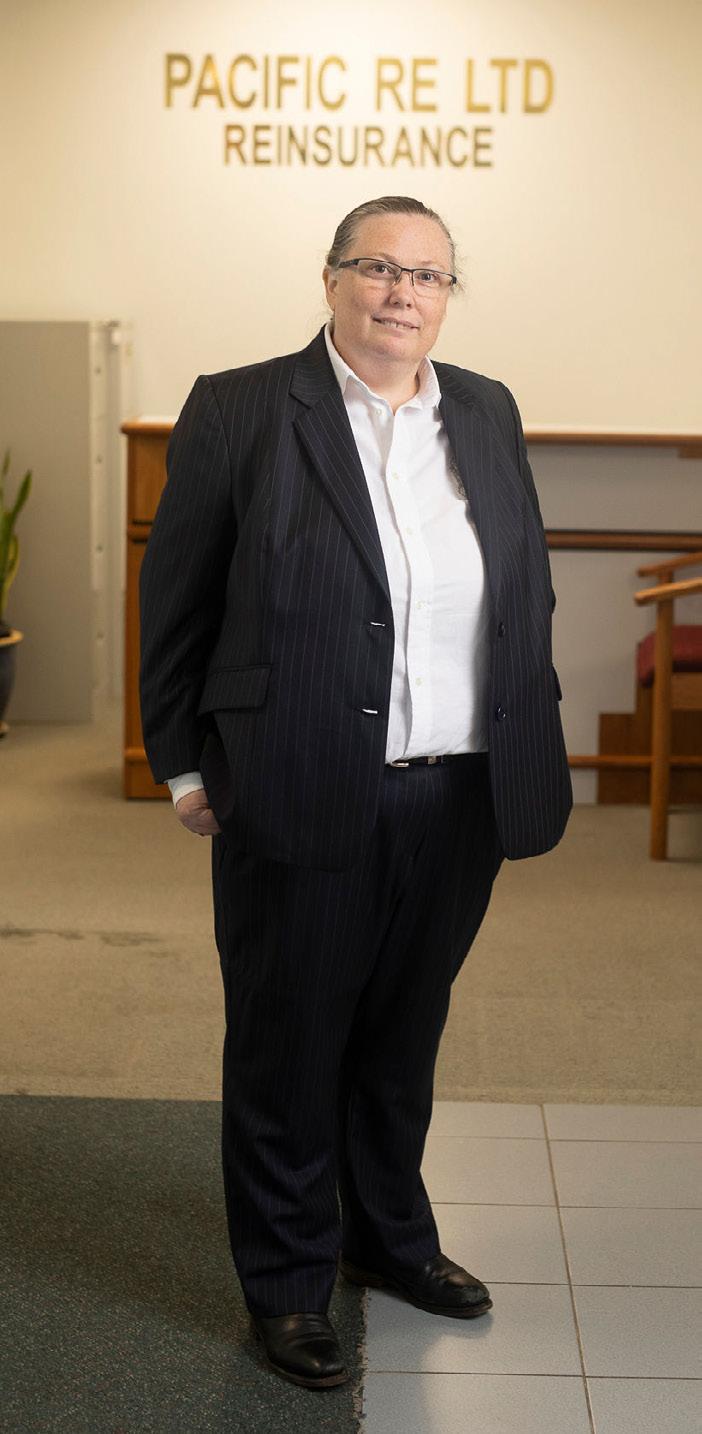
Clifford enjoys catching up with family and friends, especially building Lego with her three nephews. Away from work and family, she enjoys reading and listening to true crime stories. Building on this interest, Clifford recently enrolled in a criminology course and is enjoying being a student again.
‘Consider having mentors for different parts of your career. It is also good to have people you look up to who are not related to your work environment.’
Papua New Guinea,’ she says. ‘They are some of the nicest people I have worked with or met. Yes, it can be dangerous at times. But so can it be in Sydney and other countries.’
Clifford draws great satisfaction from the idea that she is helping develop the underwriting skills and knowledge of Papua New Guineans so that it will be locals who lead organisations like Pacific Re.
‘What we are doing here is very satisfying,’ she says. ‘I am using all that knowledge and experience I have got and injecting it into the next generation. Work here is very challenging … but it is very exciting.’


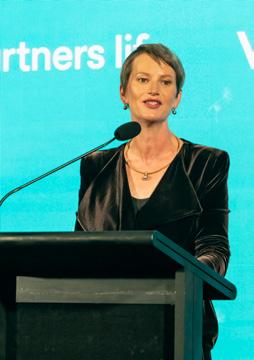




The New Zealand Insurance Industry Awards recognise the outstanding achievements of individuals and companies across all sectors of insurance and celebrate the positive impact they have had on the community. We congratulate the winners for 2022.
There was glitz, glamour and plenty of accolades at the 10th annual New Zealand Insurance Awards last month.


Hundreds of insurance professionals from across New Zealand gathered at the Cordis Hotel in Auckland on 30 November to celebrate the industry’s best and brightest with the event’s first in-person awards ceremony in three years.

The awards recognise and celebrate individuals and companies that have demonstrated exceptional dedication to the industry and share a common pursuit of excellence. Winners were named in 15 categories, including
two new categories for 2022: General Insurance Claims Team of the Year and Excellence in Environmental, Social and Governance Change.
ANZIIF chief executive officer Prue Willsford said she was honoured to be part of the awards judging panel.
‘I’ve seen first-hand the incredible ways our industry has supported customers and its people. Our industry plays such a vital role in supporting the community when they need it most; through natural disasters, the pandemic or a skills shortage, we collaborate, we innovate, we inspire.’ P
Sherpa Insurance Brokers and Advocates, based in Christchurch, is the 2022 ANZIIF Small–medium Broking Company of the Year. Founded in 2018, Sherpa has achieved a 98 per cent customer retention rate and a 100 per cent staff retention rate over the past three years.
The brokerage has invested in streamlining processes, which frees up time and resources for customer service. It also uses a verbal customer feedback process with the small to medium-sized businesses it serves to get customer views quickly and easily — and respond accordingly.
Sherpa has also invested a considerable amount in the professional development of its staff and offers flexible working arrangements for employees.
Senior broker and director Daniel Mathieson says the recognition from the industry is a sign they’re ‘doing something right’.
‘Four years ago, I started Sherpa from a spare bedroom at home, with a goal to provide quality advice for SMEs and raise the standards of customer-led service for our clients,’ he says. ‘Since then, our growth has been exponential — today we have nine staff servicing over 1000 clients.’
This year’s Large Broking Company of the Year — Marsh — has excelled in a number of different areas.
It operates with a model of user-centric collaboration and industry review to develop solutions for its customers. As an example of this, the judges applauded Marsh’s work with KiwiRail on the Pacific region’s first parametric earthquake risk-transfer model. Marsh also performed well in the environmental, social and governance (ESG) arena, with clear objectives and targets for becoming more sustainable. It intends to halve its emissions by 2023 and achieve net zero by 2050.
Insurance Advisernet New Zealand (IANZ) was recognised as the inaugural Authorised Representative Network of the Year — a new category in the awards. This win follows two previous awards as ANZIIF’s Large Broking Company of the Year.



IANZ comprises 61 insurance broking practices across the country. The judges were impressed by the network’s use of technology to work more efficiently. The result? A client satisfaction score of 94 per cent — based on the high-quality, tailored advice each practice provides.
Internally, the judges noted Marsh’s company culture is outstanding, offering flexible working conditions, professional development opportunities and an enhanced employment access program as part of its focus on staff wellbeing. The organisation also spearheads diversity and inclusion initiatives, participates on boards and partners with other companies in the industry, setting an industry standard and contributing to leadership and professionalism.
As a mark of its achievements this year, Marsh has increased staff numbers by 413, giving customers greater access to its New Zealand network.
As in other categories, the judging panel considered the ESG performance of each entrant. IANZ is committed to offsetting its carbon footprint, and its use of technology is helping achieve this aim.
The organisation also promotes resilience and wellness among network staff, as well as continual internal and external training and webinars


Vero New Zealand is ANZIIF’s 2022 General Insurance Company of the Year, following wins in 2015 and 2017.
On the technology front, Vero has automated its claims processes, resulting in greater accuracy and time savings for claims assessment and handling — sometimes reducing the time taken from 15 minutes to as little as two minutes.
The organisation has an innovative approach to the professional development needs of its growing team. This includes vulnerability and adaptive leadership training, which fits with Vero’s ‘challenge’ mindset. This is reflected in the company’s customer service too, with 21 vulnerable customers being referred to Lifeline Connect over the past 10 months — a resource fully funded for them by Vero.
In the community, the company has been involved in a number of charity projects, including the Whakatane Natural Resilience Initiative, which addresses the high risk of flooding in the area.
Jimmy Higgins, CEO of Suncorp New Zealand (which owns the Vero brand), says the award is an acknowledgement of Vero’s commitment to not only providing better outcomes for customers but also increasing access to insurance for more New Zealanders.
‘Internal professional development continues to be a central focus for Vero as, through our transition to an agile way of working, we seek to be even more responsive, be more resilient and deliver outcomes better for our customers, community and people,’ he says.
‘Through the creation of bespoke learning and development programs that support customer centricity, challenge mindsets … we’re preparing our people for the future and nurturing the growth of existing talent.’
ANZIIF’s 2022 Young Insurance Professional of the Year is Tama Rawhiti, head of risk at AIG New Zealand

Rawhiti joined the insurance industry as a claims consultant at Lumley in 2012, attracted by the ‘diverse career opportunities it offered’. Now, as a member of AIG New Zealand’s executive leadership team, he manages the company’s risk management framework and advises the CEO and board on their risk oversight obligations.
He is also responsible for crisis management, enterprise resilience, ESG and sustainability — a good fit with his own climate change advocacy.
Rawhiti has been involved in AIG New Zealand’s carbonreduce certification, which has been running for three years.
The insurer measures its carbon footprint in accordance with ISO 14064-1 and the Greenhouse Gas (GHG) Protocol. This is part of its ongoing commitment to manage and reduce its emissions.
He says he loves the variety of his role at AIG and is quick to encourage graduates to consider a career in insurance.
‘Insurance plays such a vital role in society. It’s an ecosystem that not only supports the global economy but protects individuals and businesses from the unexpected.’
‘Whether it’s working for an insurer, broker, consultancy, adjustor or one of the key service providers, there’s a place for everyone in insurance,’ says Rawhiti.
His ultimate piece of career advice is ‘think big and keep an open mind’.

For the fifth time, Underwriting Agency of the Year Delta Insurance was recognised for its outstanding company culture, innovation and ambitious ESG strategy.

The eight-year-old business now has 30 staff and has achieved 15 per cent year-onyear growth of its client base since 2015.
Key to this has been embracing change and updating technology. For example, customers can now manage their own policies through Delta’s modernised user interface (UI) model and the Delta app.
Judges also commended Delta’s ambitious ESG strategy. Delta’s co-founder and group executive director – underwriting Craig Kirk, who was also named New Zealand Insurance Leader of the Year, says the company has recognised the need for proactivity and contributing todriving positive change in the industry.
‘Our company is willing to forgo business opportunities for the sake of protecting the Delta brand,’ he says. ‘Across all lines of business, our underwriting decisions take into consideration the potential reputational implications of any unmitigated ESG concerns.’

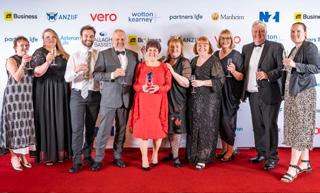 + IAG NEW ZEALAND
+ IAG NEW ZEALAND
General Insurance Claims Team of the Year is a new addition, designed to recognise outstanding technical skills, claims results and customer service. IAG New Zealand’s claims team took out the 2022 award, with judges saying the company has set a high bar for this new award category.

IAG New Zealand’s 1,126-strong claims team handled more than 400,000 claims in the 2021 financial year, helping to achieve growth of about around 3.8 per cent in gross written premiums. The company has digitised its claims processes, which has contributed to both good business results and a positive customer experience.
The judges gave the organisation’s response to the Westport floods in July 2021 a special mention as a standout example of the claims team in action. IAG New Zealand acted quickly and effectively to keep customers impacted by the event informed and supported.
IAG New Zealand’s executive general manager of claims Wayne Tippet says: ‘I’m so proud of what the claims team has achieved, and this [award] is the icing on the cake. It recognises the commitment and dedication of our people, who consistently deliver excellence — including during the significant weather events New Zealand has endured this year — and the outstanding mahi [work] the team delivers to look after our customers every day.’
Craig Kirk, group executive director –underwriting and co-founder of Delta Insurance, was recognised as the 2022 Insurance Leader of the Year.
He and Ian Pollard founded Delta in 2014, with the aim of making ‘the world a safer place’. Kirk reviewed the company’s underwriting policy to ensure the business was actively contributing to driving positive change — in line with Delta’s core value of ‘doing the right thing’.
Kirk has more than 20 years’ experience in underwriting and managing financial lines and casualty portfolios across New Zealand, Australia, the United Kingdom and Europe. The judges observed Delta had benefited from Kirk’s international experience and local knowledge, helping it introduce global innovations to the New Zealand liability market.
Kirk is also chairman of the board of directors of digital-first insurer Cove Insurance, which launched in 2018.

‘With the quality of leadership across ANZ in this industry, I am humbled by receiving this award,’ says Kirk. ‘I’d like to acknowledge my peers and the entire Delta Insurance company. We work together as a team and we win as a team.’
Kirk acknowledges that the end of economic boom times heralds a challenging road ahead.
‘We’ve faced and overcome serious hurdles within our business over recent years which haven’t been easy on our team or our leadership group,’ he says. ‘I’ve certainly learned a huge amount throughout this period, and I want to thank our amazing team for believing in our vision and plan as we transition into the next chapter of our journey.’
In another new category this year, Morgan Project Services is ANZIIF’s 2022 Insurtech Start-up of the Year.
The company specialises in disaster recovery, project management and property decontamination.
As part of its ‘people first’ ethos, the start-up has used user experience (UX) and UI modifications to enhance its FAST app — providing a better customer experience for people impacted by insurance events. The app helps fast-track the customer claims process, benefiting both customers and insurers.
Sam Ross, Morgan Project Services’ general manager — New Zealand, says he was ‘delighted’ to receive the honour.
‘This recognition means a great deal to our team, who have put in endless hours delivering the FAST app. It is an incredible achievement and something we are very proud of. This acknowledgement will only drive us as we continue to develop and use technology to put customers first and support them when they need us most.’
Partners Life won ANZIIF’s 2022 Life Insurance Company of the Year award, in a hotly contested category.

The judging panel said Partners Life’s submission stood out because of the company’s strong customer focus, successful staff retention strategy and clear ESG plan and activities.
The company uses data-led research and digital initiatives to better serve and benefit its customers. This progressive model has led to steady market-share growth.
Chris Curtin, chief executive officer of AA Insurance and winner of the 2022 ANZIIF Lifetime Achievement Award, says he is ‘genuinely proud to work in insurance, helping customers and communities recover from unexpected and sometimes life-changing events’.
Under Curtin’s stewardship, AA Insurance has grown from a start-up venture into one of New Zealand’s leading direct personal insurance companies, with over 1,000 employees, delivering more than a million policies to half a million New Zealanders.
For the second year in a row, McLarens won Professional Services Firm of the Year, based on a stand-out submission.


The firm generates all its revenue from the insurance industry and employs 263 staff in 23 locations across New Zealand.
Upcycling, responsible energy use and community initiatives are part of the organisation’s day-to-day operations, demonstrating ESG is a priority for the company. Among these initiatives, Partners Life is a support partner of the Banqer High interactive educational program, which helps secondary school students develop their financial literacy, confidence, creativity and curiosity.
In a tough labour market, Partners Life has achieved high staff retention and engagement rates. The judges pointed to the company’s employee entitlements, staff learning and development programs and commitment to diversity and inclusion as contributing factors to this success.
‘Looking back over 28 years, it’s terrific to see so many AA Insurance people growing, learning, creating successful careers and achieving their full potential in insurance and across other industries,’ he says.
Curtin adds that the company’s vision and philosophy have also reflected an unwavering commitment to developing a model that serves customers. Notably, insurance policies have been rewritten in plain language, ensuring customers can easily understand them. ‘Our purpose to care for, help and get things sorted for our customers is deeply embedded,’ he says.
‘I’m extremely grateful to have my passion for AA Insurance and the insurance industry recognised in this way and am touched to be honoured for doing something I love. I’ve met so many talented and genuine people on my journey. I wouldn’t be receiving this award if it wasn’t for all of them.’
R Read our full interview with Chris Curtin here
McLarens has a 100 per cent customer retention rate, and it has maintained this remarkable result every year since 2019. It has also seen increases in its approval rate in customer surveys off the back of improvements to service delivery. These include a self-managed customer service portal, which facilitates easier communications, real-time feedback, automated responses and prompt escalation of any issues.
The firm doesn’t forget about its own people either, with resilience, nutrition and mental health programs for staff and an active social calendar. In the community, the firm supports Autism New Zealand and Surf Life Saving New Zealand with financial and in-kind donations.
Vehicle glass repair and replacement company Smith&Smith won this year’s Service Provider to the Insurance Industry award, following previous wins in 2015 and 2017.

Judges praised the company’s growth mindset and commitment to improving the customer experience. On the customer side, this includes Smith&Smith’s webbased booking system and its tailored portal design for policyholders.
Internally, staff achievements are recognised with company awards. The business values diversity and inclusion and offers its employees multiple training and professional development options.
Smith&Smith has set science-based targets to reduce its environmental impact and is involved in government initiatives to promote road safety as part of its ESG and social responsibility work. It also supports a number of charities, including Lifeline and Afrika Tikkun
In addition to being awarded General Insurance Claims Team of the Year, IAG New Zealand also took home the 2022 award for Excellence in Workplace Diversity and Inclusion.

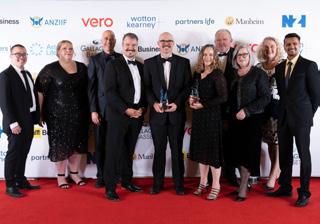
The insurer’s recruitment process focuses on reducing bias and creating equal opportunities for applicants of all ages, genders, races, ethnicities and abilities. The company already has a diverse workforce and has set itself a target to have women in 50 per cent of its senior leadership roles by June 2023.
On gender and inclusion, IAG offers support for LGBTQ employees and genderneutral parental leave. It has also updated its customer documents to be more inclusive and provides staff training to ensure all its customers have a positive experience with the business.
The organisation also has a Rautaki Ma¯ori (Ma¯ori strategy) to recognise and include Ma¯ori customers and demonstrate its commitment to Te Tiriti (actively uplifting Ma¯ori wellbeing and prosperity).
Louise Harvey-Wills, executive general manager of business partnering, IAG New Zealand, says: ‘At IAG, diversity, inclusion and belonging are fundamental to our purpose of making our world a safer place. We know that when different voices are embraced and included we create meaningful workplaces, higherperforming organisations and an equitable society. We’re absolutely delighted to receive this acknowledgement of the exceptional environment we’ve created for our people.’
Smith&Smith — 2022 winner of the Service Provider to the Insurance Industry award — also won the award for Excellence in Environmental, Social and Governance Change. This new award reflects the increasing importance of ESG for businesses as a way of driving change for good and was a hotly contested category with many strong submissions.
Judges said they were impressed by Smith&Smith’s holistic approach to ESG change. The company’s submission clearly demonstrated how it has embedded ESG into its culture locally and overseas, with a responsible-business model.
Smith&Smith audits its ESG progress, sets milestones and builds partnerships to help it achieve its sustainability goals. In particular, the company has developed partnerships within New Zealand’s circular economy: responsible resourcing, waste minimisation and disposal.
The ANZIIF Making a Difference Awards recognise individuals who have demonstrated outstanding professionalism, commitment, achievement and passion across different sectors in the insurance industry — those who have gone above and beyond in their workplace and with their customers. Meet three of the winners for 2022.
On 15 January 2022, South Pacific underwater volcano Hunga Tonga–Hunga Ha’apai erupted, triggering a devastating tsunami and blanketing many of Tonga’s islands in volcanic ash. Ali Wilkinson, Fiji-based head of Pacific operations at Tower Insurance, swung into action.
‘[Our teams] had to be innovative and nimble,’ she says. ‘With internet and communication cables severed by the eruption, international communications were cut off for five weeks. We had to receive information and share instructions by satellite phone.’
Wilkinson’s teams ran radio ads advising Tongans how to protect their assets from further damage and how to make a claim.
‘We learned from previous large events in the Pacific that inflation of building materials becomes an issue when rebuilding begins all at once,’ she says. ‘Our teams moved quickly to ensure that key suppliers were provisioning adequate supplies for the Tonga rebuild at fair prices.’
The first claim was paid as soon as online banking networks were re-established — a month after the eruption.
Wilkinson is extremely proud of her teams’ courage and commitment to supporting their customers during a difficult and traumatic time, noting that their dedication to do what’s right really made a difference to claimants’ lives.
‘The Making a Difference Award resonates with my own values and professional ethos,’ she says. ‘It also aligns with one of Tower’s core values: “Our customers are our compass”. This award is industry recognition of the value of a proactive, human-centred approach.’
(top to bottom)
Ali Wilkinson; Karen Robertson; and Sara Rusdiah.
When AIA Australia hired Karen Robertson in 2011, she became the first permanent rehabilitation consultant employed in the life insurance industry.


Today, as AIA’s rehabilitation and wellbeing team manager, she has helped to expand the team to 34 rehabilitation consultants delivering a suite of innovative programs that have assisted more than 2,500 people return to work and daily life following illness or injury.
‘We address a range of a client’s challenges, including crisis management, mental health, cancer and chronic pain, among others,’ says Robertson.
‘I’m committed to rehabilitation, because a wellthought-out program that supports and gives people the tools, resources and confidence to make changes in their life really works to get them back on the road to recovery.’
One of her greatest achievements is RESTORE, AIA Australia’s mental health rehabilitation program, which launched in 2013. Back then, says Robertson, the industry considered rehabilitation in the mental health space ‘too difficult and too complex’.
‘I can say that the success of the RESTORE program has proven this line of thinking wrong, which has improved the experience for all people on claim with a mental health condition.’
// Read our full interview with Karen Robertson here.
Two months after Sara Rusdiah started at Flex Insurance on a temporary contract as underwriting and customer service co-ordinator, the senior underwriter resigned.
Rusdiah became the only one with underwriting capacity left in the team while the company recruited for the vacant role — an experience she describes as one of her ‘most formative’.

‘I had to quickly navigate the complex world of underwriting as someone without any prior background in it,’ she says. ‘I never stopped, even during weeknights and weekends, until I had met my targets. As the saying goes, experience is the best teacher.’
With Flex Insurance growing by more than 100 per cent year on year since its launch, Rusdiah now oversees an expanded team of 10 underwriters. Her vision as team leader is to provide regular supervision and training to upskill the newly formed team to maintain excellence in customer service and meet clients’ expectations.
‘In a time of such unprecedented growth and demand, it’s essential that every one of my team becomes more independent, versatile and efficient in performing their responsibilities,’ she says.
‘There is nothing I look forward to more than seeing us grow collectively and being able to take greater pride in what we do every day.’
// Read the full interview with Sara Rusdiah here.





› Natural language processing is evolving quickly as it helps insurers handle claims faster and more efficiently.
› The technology frees up claims team members to concentrate on other elements of customer experience.
› NLP skills can be acquired through education and industry training events.
Natural language processing, a subset of artificial intelligence, is enabling insurers to automate many processes — reducing operational costs, speeding up claims handling and improving the customer experience.

IAG deploys natural language processing (NLP) to help it predict if a motor vehicle involved in an accident is a total loss or if it can be repaired, cutting claims times dramatically.

‘This has enabled us to reduce the process from what was typically 15 to 20 days to about two to five days,’ says Danielle Handley, executive general manager, Customer Experience at IAG.
Acknowledging that delays in assessing damaged vehicles and knowing the outcome are a ‘customer irritant’, Handley says NLP technology, in tandem with machine learning, helps IAG make faster judgements. ‘So, within 24 to 48 hours, a customer can have a level of confidence and clarity about their situation.’
NLP and artificial intelligence (AI) are used to translate customer conversations into text and analyse and automate claims processing where possible. ‘The context of a claims situation does come through conversation, so it’s critical for us to be able to leverage that language and any insights to understand what’s going on with a claim,’ says Handley. ‘Then, we can refine and automate some of the processes.’
Significantly, this frees up claims team members to focus on more critical aspects of the customer experience.
Handley says the discovery that targeted human interaction is still required during claims has been an important learning for IAG.
‘You can’t assume that you can go from a 100 per cent human process to a 100 per cent digitised process,’ she says.
Since 2017, IAG has increasingly been using NLP and AI to help manage high volumes of customer calls, to undertake administrative tasks and to bring personalisation to digital quoting processes. The last involves using a machinelearning, real-time decision engine that can analyse voice and digital channels and predict customer preferences based on past patterns.
Other innovations are likely to include using robot-voice AI for outbound communication, as well as digital avatars on the IAG website, to interact with customers.
‘There’s a lot of opportunity with realtime voice technology for us to more accurately engage with our customers in terms of their sentiments and how to help them in the most effective way,’ says Handley. ‘That includes better analysing and predicting ways we can support them, potential complaints and interacting with customers in a more personalised way.’
Global credit insurer Atradius co-builds customised models, using NLP and AI, that can read financial statements and annual reports and process information mined from hundreds of thousands of websites.
Operating out of Amsterdam, with regional offices in Singapore and Sydney among more than 160 locations around the world, Atradius also uses neural networks — a form of AI that mimics the human brain through a set of algorithms — to deliver automatic credit decisions.
‘This saves us tremendous amounts of time and manpower, expands the scope and reach of the information in a fast-changing world, and brings immediacy to the way we manage portfolios and make risk decisions,’ says Stan Chang, director Group Buyer Underwriting at Atradius.
He adds that NLP and AI technology is ‘an important driver in our business, as it frees up humans to perform complex tasks like servicing customers and selling policies’. It also delivers savings for Atradius through greater efficiency and productivity, while allowing higher-quality and faster underwriting decisions.
‘There’s a lot of opportunity with real-time voice technology for us to more accurately engage with our customers ...’
Danielle Handley / IAGChang / Atradius
Chang says better-informed, data-led decisions mean that customers benefit ‘from our increased willingness to insure their trades’. Given that Atradius processes high volumes of credit applications globally and manages a massive portfolio of credit risk exposures in hundreds of trade sectors, he says the use of technology is a must. ‘Aside from complexity, the cost of doing this well is prohibitive without technology, considering the highly competitive premium rates that we charge.’
The biggest challenge for Atradius in embracing such technology has been adoption. ‘This has entailed using unfamiliar technology to deliver a proof of concept, building prototypes that can be scaled, and not knowing all the answers to important questions from the outset to translate a new technology into useful business outcomes,’ says Chang. ‘[But] we had faith. We researched and collaborated. We were excited about what we were doing, and we received much internal support and encouragement.’
For others considering using NLP and AI, Chang advises building knowledge through education, networking and attending relevant industry conventions. ‘You don’t need technical knowledge to strategise your approach,’ he says. ‘Be purposeful and focused in your business goal rather than romancing the technology. When you’re ready, acquire skills if you don’t have them already — either through training, recruitment, collaboration or outsourced services, or a combination. Start small.’
The key, however, is to act. ‘Few businesses that shun technology will survive, much less prosper,’ says Chang.
New Zealand-based Tower Insurance is fighting back against claims fraud through a partnership with FRISS, a Dutch company that provides AI-powered fraud and risk detection solutions.
Tower chief claims officer Steve Wilson says that late last year, the insurer recognised the need to pay claims faster and joined forces with FRISS to automate the process of detecting genuine and suspicious claims.

‘Many insurers have dedicated fraud teams, but it’s a time-consuming process identifying each claim as genuine or fraudulent,’ says Wilson. ‘AI complements what our humans do. By learning from our investigations, AI can pick up on systemic trends and identifiers happening across Tower claims that, as humans, we sometimes cannot see in isolation.’
The FRISS solution features AI and NLP techniques such as predictive models, network analysis and text mining. By inputting historic data on genuine and fraudulent claims, the tool can sift through new claims in seconds and detect suspicious cases. ‘Having an automated process that separates low-fraud-risk claims from the rest of the pile significantly speeds up the process and enhances accuracy,’ says Wilson.
He adds that insurers with automated fraud-detection systems can also harness real-time data to respond swiftly as new scams are detected, mitigated and prevented. ‘It brings more transparency into how claims are processed, which simplifies insurance for everyone involved.’
Wilson says technology and data are at the forefront of Tower’s strategy to innovate within the insurance industry, while helping customers with simpler and more rewarding
insurance experiences. He is confident that embracing the technology brings mutual benefits for customers and staff alike. ‘Customers love that their claims are dealt with fast and with less hassle, but it’s also hugely beneficial for our people and business,’ he says.
While the alliance with FRISS is in its early days, Wilson says it is an important move for the business.
‘Tower is dedicated to helping Kiwis prepare for the unexpected. So, it falls on to us to ensure we have the most efficient system in place to reduce unnecessary costs and improve customer experiences.’
‘Be purposeful and focused in your business goal rather than romancing the technology.’
Stan
‘Insurers must keep refining and improving the way they execute claims tasks with natural language processing and AI. This story demonstrates how three renowned insurers are embracing NLP — and it is delivering real benefits for them and their customers.’
CAMERON COOPER Freelance writer


Supply chain disruption isn’t new; however, a confluence of recent factors has left a substantial gap in the market for marine cargo insurance customers dealing with the impact of delay.

› A confluence of economic and systemic factors is leading to increasingly unsustainable delayrelated costs for shippers of marine cargo.
› For brokers, who are the meat in the sandwich between impacted clients and insurers, one option for innovation is deepening their roles as risk managers and relationship builders.
› With ever-more-sophisticated technology improving supply chain visibility, brokers could also partner with likeminded stakeholders to create new solutions that satisfy the underwriting risk appetite.
For global shippers and importers of product, the biggest and most costly current risk is delay.
With the majority of goods still shipped on the ocean, today’s global supply network is marked by everincreasing traffic. Added to this, most ports and terminals struggle with inadequate infrastructure that’s failing to keep up with changing volumes and technology. The inevitable result is ships being held up and the accumulation of cargo.
Cover for the financial losses caused by congestion at the ports is a constant theme for customers, says Neil Hiller, founder and director of Hiller Marine, a company he cofounded in Australia that serves as both an underwriter and a broker.
‘Supply chains have become unreliable,’ he says. Delays caused by a shortage of capacity and port congestion mean clients lose sales or suffer depreciated prices when perishable products finally get delivered undamaged but past their use-by dates.
If cargo is sitting at the port for prolonged periods, the shipper is liable for expenses charged by freight providers and stevedores, which can come as a shock to many insureds with a standard cargo insurance policy.
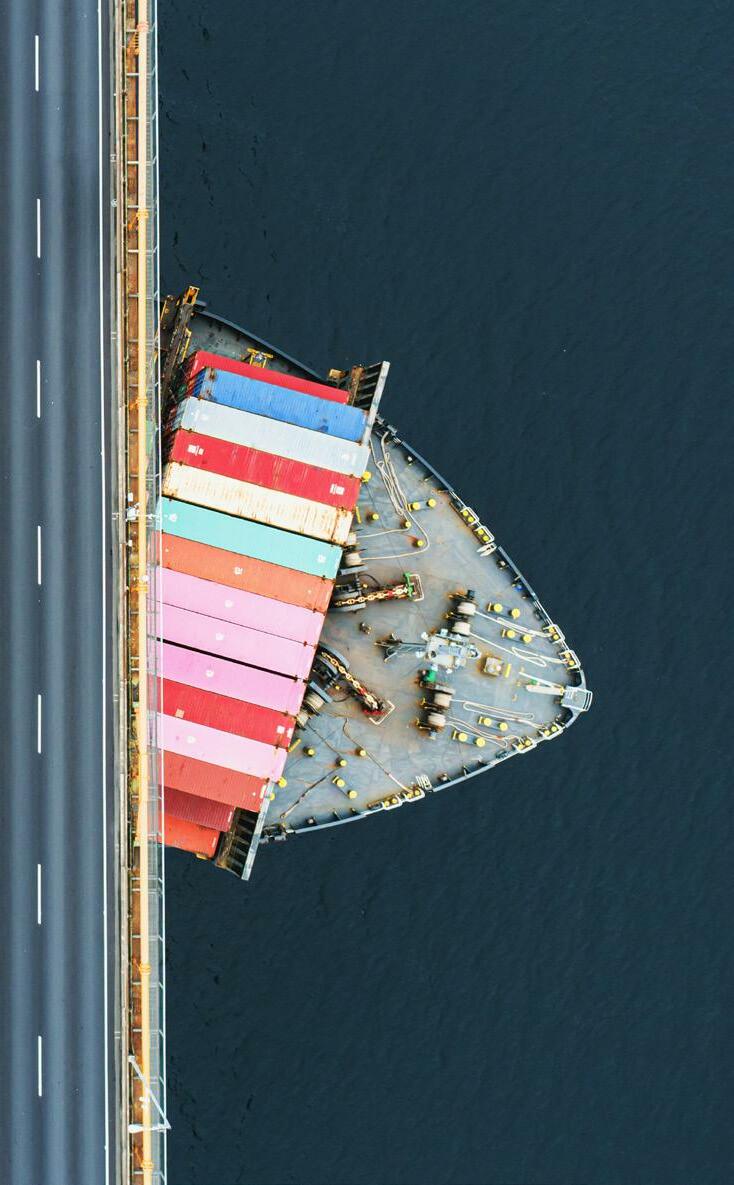
‘They’re telling me, “I’ve just copped a bill for 50 grand. Am I covered?”,’ says Hiller.
In addition, suppliers are facing inflation, especially higher fuel costs and higher wages. ‘There’s a lot going on in the economy impacting prices for importers and exporters trying to get their goods to buyers overseas,’ says Daniel Morrison, head of Marine Portfolio, National Transport Insurance (NTI).
Over the past 20 years, the size of vessels coming into and out of Australian ports has tripled. While there’s a decline in the number of vessels calling, the number of containers being moved has increased. Unprecedented demand caused by rapid changes to consumer buying habits has exacerbated the issues shippers face.
‘We lose more containers at sea than ever before because we put more containers on vessels and we stack them higher than we did in the past,’ says Morrison.
The pandemic has added further uncertainty to the mix. Fragility and disruption in the supply chain is causing some shippers to rethink their strategy. More are hanging on to stock ‘just in case’ rather than dispatching it to cater for ‘just in time’. ‘Now they’ve got a greater accumulation of goods at their own premises, or they’ve got to manage their own stock, plus their distribution,’ says Morrison.

Sarah Chang, national marine executive at Aon, says many customers are investing more in insurance, paying higher premiums to afford increased sublimits, spending on additional insurance policies to cover the more unconventional risks and incurring costs as a result of not being able to meet the demands of their buyers.
Given that global customers all face similar risks, Stephen Rudman, head of Marine, Transport & Logistics at Gallagher, says the best way brokers can advocate for their clients is by consulting with them to properly understand their risk profiles and to design an insurance program that ‘best protects their customers’ risk exposures when shipping goods’.
‘Marine cargo insurance is one of the oldest forms of insurance, dating back to Lloyd’s of London in the 1600s,’ says Rudman. ‘Delay has always been a point of discussion; however, it is and always has been an exclusion under marine cargo insurance.

Rudman adds that depending on the circumstances, marine cargo insurance is available to cover customers for cargo risks and marine loss of profits arising from a delay to their project under marine project cargo and delay in start up (DSU).
Stephen Rudman / Gallagher‘This insurance, typically more costly, is generally for clients with large, complex and unique risks such as power generation, heavy industry and mining,’ he says.
Morrison and Chang both point out that extended coverages are also available in the event that perishable items, such as fruit or vegetables, suffer a physical deterioration due to a failure to arrive at their destination on time.
They believe that marine cargo insurance won’t be changing to cover delay any time soon. ‘It should be remembered how detrimental [covering delay] would
‘Marine cargo insurance is one of the oldest forms of insurance, dating back to Lloyd’s of London in the 1600s …’
be to the marine cargo industry, especially having just been through a hard cycle,’ Chang points out. ‘If everyone was claiming for delay, the industry would be hit hard. Insurers would wear this, and it would become more expensive for our clients to buy the necessary insurance in the long run.
Hiller begs to differ, suggesting that Lloyd’s was the home of innovation among brokers, who were the original authors of marine cargo products. Marine insurance products evolved incrementally from covering a few named perils to the wider cover they offer today,’ he says. ‘Why shouldn’t they continue to meet market needs?’
Hiller believes clients consider financial loss caused by unexpected delays to be as serious a risk as loss or damage to the cargo. ‘Modern brokers could work with underwriters to design affordable cargo insurance products that cover elements of delay,’ he says. ‘Unfortunately, what we’ve got now is a scenario where the average underwriter continues to have limited scope for taking risks.’
He adds that what’s required is a basic, practical cover that meets the needs of most importers and exporters rather than the few very large clients.
‘If you want to be innovative as a broker, look beyond the current cover for physical loss or damage to cargo,’ he suggests. ‘Look at what clients are calling out for. In my experience, that’s insurance for additional costs and financial losses caused by unforeseen delays after a shipment has departed.’
To that end, Hiller collaborated with underwriters to develop a supply chain risk solution that covers physical loss and damage as well as covering clients impacted by supply chain delays outside the policyholder’s control (see breakout, left). The product also provides protection against a variety of supply chain costs and liabilities.
Beyond Asia Pacific, London-headquartered company Concirrus takes current Internet of Things (IoT) technology further using data to cover delay.
‘In its most general sense, IoT devices allow you to know what was previously unknowable,’ explains Concirrus founding CEO Andrew Yeoman, ‘For marine cargo, this can be the location and condition of the goods. You can measure temperature, humidity, light and shock, and this will allow you to monitor precious cargo in near real
Chief insurance officer with marine cargo insurance start-up Parsyl, Gavin Spencer works with brokers to negotiate marine insurance coverage for clients and familiarise them with the company’s technology.
Parsyl was launched in 2018 in the United States to create supply chain transparency for perishable products, starting with vaccines transported within sub-Saharan Africa and other low-income nations. As the pandemic hit, Parsyl entered a partnership with Lloyd’s to launch the Global Health Risk Facility which strengthened supply chains for critical health and humanitarian treatments and supplies, including COVID-19 vaccines.
‘In doing that, we realised you have to build a better way to capture data,’ says Spencer.
Initially a hardware company building its own IoT (Internet of Things) devices, Parsyl’s insurance arm switched focus to look into the potential of capturing supply chain data such as temperature and humidity.
Spencer says Parsyl’s inherent understanding of a product’s scientific profile is the backbone of its ability to cover for delay. ‘We build an algorithm for each commodity covered, which we call “shelf life lost”. We can therefore start to equate delay with a meaningful valuation,’ he explains.
Spencer adds that the technology is user-friendly, customer-focused and essentially ‘plug and play’.
‘For brokers, it’s about giving their customer a huge value-add, which
doesn’t cost them a thing,’ he says. ‘We don’t upcharge the insurance premium. And we make the broker feel comfortable that it’s not me, the insurance guy, that’s going to talk to your customer about technology. It’s this brilliant team of customer success individuals.’
When Parsyl customer Asian Pacific Seafood was notified earlier this year that the Ever Forward vessel was stuck in the Chesapeake Bay with its container of crabmeat, it prepared for a total loss valued at US$340,000. A transit that typically ranges 45–60 days was extended to a total of 103 days on the water. Upon arrival at Asian Pacific’s cold storage partner facility, the container was unloaded and device data was wirelessly transferred to the Parsyl platform.
Parsyl’s two Trek Tab devices within the container had continually monitored the entire life of the shipment, despite the massive delay. The data was automatically shared between Asian Pacific, Parsyl and the cold storage partner, which were all able to analyse the conditions of the goods and confirm that the crabmeat had stayed within acceptable temperature conditions and was safe for consumption and sale. While it can be assumed that many claims were made on the Ever Forward, Asian Pacific was able to provide evidence of commodity integrity — avoiding a claim, undue waste and increased insurance rates — and could pass the product to consumers without concern.
‘For brokers, it’s about giving their customer a huge value-add, which doesn’t cost them a thing.’
Gavin Spencer / Parsyl
time and be proactive to mitigate claims or speed up the claims process. ‘While this is great on an individual shipment basis, it doesn’t solve some of the wider market issues such as the aggregations and supply chain challenges we’re discussing.’
Concirrus curates and analyses vast datasets on the movement of goods globally, such as bills of lading and commercial invoices.
‘By harmonising the data, cleaning the contents and categorising the information according to market standards such as the HS [Harmonised System] commodity codes, we’ve now built a “digital twin” of the world’s marine supply chain,’ says Yeoman. ‘We use this to provide valuable information to help the insured, brokers, insurers, reinsurers and ship operators understand their exposures.’
In Australia, NTI’s Morrison says the development of technology is on the agenda, ‘but as an industry, we’re really at the very beginning of that journey’.
‘For brokers, it’s still that relationship exercise,’ says Morrison. ‘The best approach is to talk to customers and make sure they’re talking to their logistics providers.’
Rudman expands, suggesting that while there’s clearly an important place for technological advancement in cargo insurance solutions, the more complex, larger cargo being shipped requires the ‘intellectual intelligence that a specialist insurance broker with experience in the marine insurance industry can deliver’.
‘Processing for complexity of global supply chains and customers is quite a challenging task,’ agrees Morrison. ‘The development of technologies will become more prevalent if stakeholders agree to share granular data and customers are able to track and monitor their supply chain risks. Then we can provide more detailed information to the underwriter to ensure a clear policy and adequate coverage.’

Veenet Muthraja heads up an innovation team for Munich Re in Germany, looking at how marine cargo insurance can be improved using a combination of Internet of Things and underwriting strategy.
‘We collaborate with our clients to co-create new solutions, new offerings and new distribution models for marine cargo insurance,’ he says.
Muthraja is confident that a time will come — potentially within the next three to five years — when delay is no longer excluded in marine cargo insurance.
‘My job is not to explain why [covering delay] isn’t possible,’ he says. ‘My job is to see how we can make it possible and discern the baby steps we can take.’
As an example of what can be achieved, he points to a broker initiative Munich Re ran with Aon early in 2021, in which an industry cover was developed for COVID-19 vaccines. The solution involved an expedited payout for shippers in the event of either loss or delay.
Muthraja says one of the main impediments is defining exactly what will be covered. ‘Basically, delay is a business risk. There’s a big difference between what a client wants to have
covered and the insurer’s appetite,’ he says.
The human factor is a key element of this challenge. ‘Human beings make decisions with foreseeable consequences. But how do you know whose decision it was? Perhaps it’s simply a case of changing the policy wording or how you read and apply it.’
In addition, Muthraja says from a regulatory perspective, the insurer’s job is to indemnify for a quantifiable loss. ‘So [in the case of delay] what do we cover? Is it the value of the goods? Well, they’re just delayed. If it’s something that’s not sensitive to humidity or shock, maybe the client can sell it somewhere else?’
Muthraja suggests brokers put together a shortlist of innovative stakeholders who might be interested if a client asks for a solution for a delay-related problem.
‘A common stumbling block with new solutions and products can often be a failure to find people with the same priority in each part of the value chain,’ he explains. ‘You might have an innovative reinsurer but are struggling to find an insurer.’
Muthraja suggests brokers partner with companies they feel will bring value. ‘I’m deliberately not saying tech companies, because companies that have been there for 120 years might be the right fit for your client or the right connector.’
‘It’s only a matter of time before competitive pressure and the demand for some form of standard and affordable delay coverage create the need for underwriters to respond. Innovative brokers will be open to the possibilities rather than set on the status quo.’
OfficeTechNow offers an easy-to-use approach for sharing, distribution and storage of your workplace documentation with all of the standard OfficeTech features including the workflow tasking module, template tasks and more. Browser based so you can access from anywhere with an internet connection. The result is a paperless environment that will change the way your office operates.





The recent collapse of the cryptocurrency market focused attention on insurance options in the sector. But how do you insure something with very little historical data, a value that fluctuates wildly and that operates under great regulatory uncertainty?

› Cryptocurrencies offer significant opportunities for insurers, although there are challenges to overcome.
› The volatility of the currencies is a major concern.
› There is a pressing need for clear and consistent regulation globally.
The transaction volume of cryptocurrencies tracked by blockchain data platform Chainalysis grew to US$15.8 trillion in 2021, up 576 per cent on the previous year. Over the same period, criminals acquired cryptocurrencies worth US$14 billion — a significant but much smaller increase of 79 per cent.
This combination of rising popularity and threat sounds like a massive opportunity for insurers, but, so far, the industry has been characterised by huge demand with little supply or capacity.
Most of the cover that is available is designed to protect institutions such as crypto exchanges against the loss of assets following a breach of security. Assets can include the currency itself and non-fungible tokens (NFTs — see breakout pg. 56).
‘This is still a very new market and there aren’t many insurers who are willing to underwrite the risk,’ says Timothy Chan, senior associate and insurtech lead (Australia) at Norton Rose Fulbright. ‘The main obstacle is that the crypto sector has suffered so many hacking losses.’
Within a crypto exchange, assets are protected by private keys.
‘Anyone who has a private key can access everything in that account,’ says Chan. ‘Essentially, these keys are just a combination of letters and numbers and, as exchanges hold so many, they can unlock a great deal of wealth. This makes them an irresistible target for hackers.’
Wotton + Kearney senior associate Jessica Chapman, who won the Australian Insurance Law Association’s inaugural Gill Award for her paper on insuring the cryptocurrency industry, points to the importance of the checking process. ‘Insurers must be willing to conduct in-depth due diligence on the cybersecurity, governance and storage perspective of every prospective client,’ she says.
The second type of cover, transaction risk, relates to smart contracts on the blockchain. Smart contracts, usually denominated in a cryptocurrency, can be used for realworld transactions such as lending money. They can also fund parametric insurance — a policy that automatically triggers under certain circumstances, such as if a cyclone occurs.
‘In this case, insuring the smart contract would provide cover for the unexpected — for example, if a cyclone does occur but the contract fails to pay out due to a coding error or malignant intervention,’ says Chan.
Instead of shifting this kind of risk to traditional insurers, decentralised finance (DeFi) projects are offering protection.
Says Chan: ‘DeFi uses smart contracts to allow participants within crypto markets to share the risk with each other, so it’s also a form of investment for those who take part.’
The widely publicised volatility of cryptocurrencies is a challenge for insurers.
‘Payouts can fluctuate significantly, especially if they’re in a fiat currency,’ says Chan. ‘For instance, if you’re insuring bitcoin and the insurer either buys bitcoin or pays out in Australian dollars, that could theoretically end up being a dollar
OneDegree Hong Kong entered into a three-year strategic partnership with Munich Re in April this year to launch OneInfinity, a digital asset insurance product.
OneInfinity was designed specifically for digital asset trading platforms, custodians, asset managers and technology providers. It bundles OneDegree insurance with solutions provided by cybersecurity assessment platform Cymetrics.
Helen Ye, chief commercial officer of OneDegree, says the partnership with Munich Re is a ‘game changer’ that will enable both companies to ‘broaden our understanding of the full spectrum of risks relating to endto-end digital asset operations’.
‘We are confident that the partnership will contribute to establish best practice in risk management for the digital asset industry,’ she says.
‘The main obstacle is that the crypto sector has suffered so many hacking losses. Anyone who has a private key can access everything in that account ... they can unlock a great deal of wealth.’
Timothy Chan / Norton Rose Fulbright
Non-fungible tokens (NFTs) are units of data stored on a blockchain. Broadly, ‘nonfungible’ means that the token is unique and irreplaceable, and NFTs can represent ownership of anything — including digital assets such as music or art.

The NFT can be compared with an original, physical artwork in that it’s easy to reproduce, but there can only ever be one owner. However, issues such as copyright are still somewhat hazy.
There are still currently very few ways to insure NFTs.
‘There’s only a handful of specialist insurers that cover NFTs, with no appetite for this risk among larger insurers so far,’ Steadfast’s broker technical manager Michael White writes on the Steadfast website. ‘Insurers in general are less inclined to provide cover over digital assets or are only prepared to provide restricted cover. In particular, the increasing incidence of scams involving NFTs [makes the risk] unpalatable to mainstream insurers.’
Those who do offer cover tend to be fine art and specie insurers rather than cyber specialists.
‘Insuring NFTs is more closely aligned to protecting real-world art against physical loss or damage, as it relates to physical storage of the private keys,’ says Norton Rose Fulbright’s Timothy Chan.
There are examples of insurers globally starting to enter the cryptocurrency insurance market; however, they are relatively few and far between and minimal details have been made public.
‘In early 2018, XL Catlin, Chubb and Mitsui Sumitomo were reported as providing cover for companies which held cryptocurrencies,’ says Chapman, ‘and AIG has had an interest in cryptocurrency theft coverage since as early as 2015, though few policies have been written.’
To date, no Australian-based insurers have publicly expressed interest in the sector, although Independent Reserve became Australia’s first insured cryptocurrency exchange in 2020. Underwritten by Lloyd’s of London and launched through its syndicate Atrium in conjunction with Coincover, the product is designed to insure cryptocurrency held in online wallets.
Despite the challenges, Chapman sees significant opportunities for insurers.
‘The market for cryptocurrency insurance is estimated to be worth between US$200 million and US$500 million in annual premium revenue once insurers work up the courage to accept the risks and establish guidelines and internal policies around them.’
or millions of dollars. On the other hand, if insurers pay out in crypto, they may need to hold crypto in reserve, and that creates regulatory risk.’
Lack of regulatory certainty is another serious concern.
‘In the Asia-Pacific region, there are huge disparities between whether and how cryptocurrencies are regulated,’ says Chapman. ‘China and South Korea are among the strictest jurisdictions and others tend to be growing stricter year on year.’
In New Zealand, Inland Revenue treats crypto assets as a form of property like gold, as neither can produce income until is is sold. A tax applies to both the acquisition and sale of cryptocurrencies.
In Australia, the Australian Securities and Investments Commission has issued guidance to the effect that, in most cases, a crypto asset will be treated as a financial product for regulatory purposes. Cryptocurrency exchanges, which facilitate the sale and exchange of cryptocurrencies, may then be treated as financial markets.
‘If this is the case, the operator of the exchange will be required to hold an Australian market licence and be subject to applicable regulatory rules,’ says Chapman. ‘The government has also released several consultation papers flagging other potential regulatory and licensing models to make sure any remaining regulatory gaps are plugged in the crypto asset ecosystem.’

‘This is a new type of liability insurance policy with a dynamic limit that increases or decreases in line with the price changes of crypto assets,’ Lloyd’s said in a statement. ‘This means that the insured will always be indemnified for the underlying value of their managed asset, even if this fluctuates over the policy period.’
There are also a few insurance options for individuals.
‘BlockRe offers policies to crypto asset holders providing cover for loss or theft of private access keys and hacking, among other things,’ says Chapman. ‘In September 2019, Axa XL announced it would provide contractual liability insurance to Hoyos Integrity Corp for amounts paid out if there was a breach of its digital hot wallet. Wallet users could be reimbursed up to US$1 million.’
In New Zealand, cryptocurrency retailer Easy Crypto guarantees customer funds as they transit through the company’s systems. However, unlike an exchange, Easy Crypto doesn’t store cryptocurrency funds, so the cover is limited.
By Abigail Murison
0.25 CIP pts
R Take me there
By Tim Lea
0.5 CIP pts
R Take me there
‘The cryptocurrency ecosystem has been described as the Wild West of financial services. The Australian Government is leading the way by embarking on a virtual stocktake of the sector, but insurers may continue to wait until they have more certainty.’
DOMINI STUART Freelance journalist
‘The market for cryptocurrency insurance is estimated to be worth between US$200 million and US$500 million in annual premium revenue once insurers work up the courage to accept the risks ...’
› Reinsurers are adopting digital solutions to address problems and opportunities across the value chain.

› Although some reinsurers are developing tech innovations internally, partnerships with insurtechs are increasingly common and there is still significant room for growth in this space.
› There are many emerging technologies on reinsurers’ radars, but tools that optimise their capacity to collect and analyse data offer the biggest opportunity for value creation.

Smart reinsurers continue to identify major challenges and opportunities in the insurance value chain and they’re partnering with insurtech companies to develop innovative solutions.
Insuring the insurers gives the reinsurance industry a unique perspective on the dynamics of risk and loss. They have a vested interest in helping insurers understand and price risk appropriately and operate more efficiently, plus they have the funds to invest in these improvements.
Profitable insurance lines, where premiums more than cover the cost of claims, also contribute to maintaining or increasing the reinsurance capacity in the market. Ultimately, this delivers better insurance access and affordability for communities, creating a virtuous cycle.
With these goals in mind, partnering with, or investing in, insurtech companies can be a win-win for reinsurance. Over the past four years, insurtech has provided investors with solid returns — making these companies sound investment prospects. In addition, reinsurers can choose to back companies that solve the issues in the insurance supply chain that increase loss ratios.
In the Gallagher Re Global InsurTech Report 2022 Q2, researchers note that volatility in global markets and increasing inflation have put pressure on start-up insurtechs worldwide. Like many small businesses, some will fail, but this also helps sort the strong performers from those with less robust propositions and structures. Many of the surviving insurtechs will also be open to new partnerships with reinsurers to provide a cash injection and stability.
According to Vanessa Dobson, board director at Insurtech Australia, digital innovation has the potential to reshape the reinsurance industry in many ways, whether by creating internal efficiencies, removing friction points from the customer journey or leveraging data more strategically.
‘Digital initiatives that lower operating costs and / or enable data to come through in a more uniform, standardised way is a win for customers, insurers and their reinsurance partners,’ she says.
As Dobson points out, it’s a mutually beneficial arrangement: insurtechs are supported by the incumbent reinsurers to bring their offerings to market, while reinsurers, in turn, are handed ready solutions that enable them to address customer pain points, access new markets or drive competitive advantage.
As the smoke settles over communities ravaged by bushfire, or homeowners inspect the destruction inflicted by catastrophic storms or floodwaters, insurers are inevitably hit by an influx of claims as policyholders seek to recover and rebuild.
In these situations, the claims process can be complex and drawn out. Reinsurers are increasingly turning to technical innovations to help insurers streamline the experience for everyone involved.
Munich Re’s CatAI Solution, for example, developed in partnership with the Geospatial Insurance Consortium, delivers fast damage assessment in the immediate aftermath of extreme weather events. Using highresolution aerial imagery, remote sensing and artificial intelligence, the product enables insurers to assess damage remotely so they can allocate resources appropriately and increase efficiency in the claims management process. Munich Re also offers Remote Inspection Solution: a virtual site assessment tool that allows insurers to conduct live video calls with customers to collect and verify detailed documentation — including aerial imagery — to support their claim.
‘Digital initiatives that lower operating costs and / or enable data to come through in a more uniform, standardised way is a win for customers, insurers and their reinsurance partners.’
While Munich Re was undoubtedly one of the early insurtech adopters — and has acted as ‘matchmaker’ on occasion between insurers and insurtech start-ups and scale-ups — it is by no means the only reinsurer taking advantage of new technologies to identify and solve problems along the insurance value chain. At Swiss Re, for example, innovative solutions are a key pillar of the company’s strategy to respond to client needs. According to Lauren Liang, global head of Partnerships and Propositions Innovation at Swiss Re, clients look to the reinsurer for support with tech-powered and data-driven solutions, risk consulting and new product developments. ‘They want our help to have them grow, improve profitability or operational effectiveness,’ she says.

Swiss Re’s Rapid Damage Assessment solution for flood risk employs remotesensing technology to optimise the claims process for property insurance. It has already been used successfully after major flooding events in Australia, facilitating a quick overview of damage and assisting in the loss estimation and subsequent reserving process.
Meanwhile, the company’s P&C Analytics solution delivers comprehensive market analytics, detailed insights into loss drivers, customer segmentation approaches and behavioural economics analysis. As Liang explains: ‘Solutions are where we bring our risk knowledge to the fore to help our clients develop, expand and enhance their business across the insurance value chain.’
‘[Insurers] want our help to have them grow, improve profitability or operational effectiveness.’
Lauren Liang / Swiss Re
Liang says insurtechs bring fresh ideas, challenge legacy practices, embrace agility and lead the way in using additional data and analytics to enhance the company’s understanding of customers.
‘On the other hand, reinsurers have a deep understanding of proven risk methodologies, which lay the foundation for the industry’s resilience,’ she says. ‘We believe combining these two highly complementary and critical areas and collaborating through partnerships is the way to accelerate the transformation of the industry.’
In March 2022, Swiss Re announced a new global collaboration with insurtech dacadoo, which delivers the plug-andplay health and wellness engagement platform behind Swiss Re’s MyWellLife offering. Providing health guidance, support, motivation and rewards, MyWellLife enables insurers to facilitate premium discounts and dynamic underwriting possibilities for clients by leveraging lifestyle data shared by consumers.
With health and wellness an important area for the (re)insurance industry, Liang says: ‘We believe there is an opportunity to engage consumers on this topic to encourage improvements in lifestyle factors such as activity, sleep, nutrition and mental wellness. In turn, this data allows our industry to help consumers achieve more personalised and enhanced risk assessments of their health.’
Munich Re has likewise formed a number of strategic partnerships. One focus area for the reinsurer is risk management solutions in automotive insurance. As electric vehicles (EVs), autonomous vehicles and vehicle sharing become more common, the motor vehicle insurance line will undergo immense change. There are new sources of risk impacting underwriting, and more complex vehicles and ownership models typically result in higher claims costs. Whether EVs and driverless vehicles are a better or worse reinsurance prospect is yet to be fully determined.
In China, one of the company’s subsidiaries, SiTao, has partnered with Advanced Driver-Assistance Systems (ADAS) manufacturers to implement an insurance solution to manage risk along the commercial trucks value chain. Offering quantitative risk assessment, operations and maintenance services for ADAS devices,
and claims assistance (including the reconstruction of accidents via alerts from the device), the solution has been designed to help drivers reduce the frequency and severity of accidents and ensure lower loss ratios. And in Germany, Munich Re, ERGO, in-tech and MaLiBu are working together in a Mobility Technology Center (MTC) to provide data-based risk analysis and assessment to insurers, manufacturers and related service providers. The reinsurer says the MTC was launched to help develop new, innovative motor insurance products by, for instance, assessing risks related to battery safety and driver-assistance systems.
The MTC’s expertise will assist insurance product developers and underwriters with more accurate policy design and pricing, to keep vehicle insurance lines affordable, profitable and reinsurable.
Looking forward, Liang says Swiss Re’s life and health focus in the Asia Pacific will centre on three areas: medical advancements in disease screening, such as liquid biopsy, and emerging treatments for critical illnesses; underwriting innovation; and tech and analytics tools to help insurers grow and manage their portfolios. The team is also keeping a watchful eye on new technologies that don’t directly impact the insurance industry but could provide a ‘signal’ for what’s to come.
‘In particular, we track new technologies that have the potential to change or affect how consumers live and manage their health, as these indirectly impact new behaviours and risk levels,’ says Liang.
For Dobson, investment in such technology is a strategic path for reinsurers, though she believes local players still have a way to go — understandable, given that many have been focused on regulatory shake-ups in recent years and have had limited dedicated resources to pursue innovation opportunities. With global trends showing that investment in insurtech continues to grow significantly, Dobson predicts local reinsurer representatives will soon make their move.
‘Some of the offerings that insurtechs have come up with are truly great,’ she says. ‘These offerings have made, and will make, a significant impact on customer experience and, hopefully, lead to smart product design: new products that people need — in addition to the traditional house, life and car — that can be both sold and used digitally, and personalised.’
READ // Reinsurers’ role in insurance affordability
By Zilla Efrat 0.25 CIP pts
R Take me there
READ // Monsoon modelling: staying ahead of the storm
By Cameron Cooper 0.25 CIP pts
R Take me there
BETH WALLACE Freelance writer‘It’s always fascinating to learn about new or previously under-utilised technologies changing the way we operate. Like organisations from any industry, reinsurers are trying to keep pace with, or ideally set trends in, an ever-changing world and are exploring how technology can make their processes simpler and more efficient. Particularly as catastrophic natural (and human-made) events become the norm, it will be interesting to see the solutions they come up with.’

As the global population ages, the number of people living with dementia is increasing. Could bespoke dementia insurance products be the way forward for life insurers?

› As life expectancy increases around the world, so too does the incidence of dementia — impacting those diagnosed with the disease, their support network and communities.
› In Japan and South Korea, some life insurers have introduced bespoke dementia insurance policies that cover a range of medical and nonmedical costs, catering to their ageing populations.
› Ordinary life insurance may provide limited dementia cover up to age 65 or 70. ANZ insurers have an opportunity to innovate with a local solution, learning from the APAC products in market.

Modern medicine, sufficient food and better hygiene are just some of the factors that are helping us live longer. In the Asia-Pacific region, the life expectancy is 85 years in Japan, 84 years in Singapore, 83 years in Australia and South Korea and 82 years in New Zealand. But hand in hand with our longevity comes the increased incidence of diseases that typically strike in old age — and one of those is dementia.
Dementia — typically in the form of Alzheimer’s disease — is most common in people aged 65 and older. By 2050, the number of people living with dementia globally will almost triple: from 57 million to 153 million.
Already, the numbers are staggering. Sally Phillips, head of health services at Zurich Australia and New Zealand, says dementia is currently the second-leading cause of death in Australia overall and the leading cause of death in women over the age of 75. Statistics from Dementia Australia reveal there are approximately 487,500 Australians living with dementia, and modelling indicates this figure will reach 1.1 million Australians by 2058.
‘Younger onset dementia currently affects more than 28,000 people, which is expected to rise to more than 29,000 people in 2028 and more than 41,000 people by 2058,’ she adds.
Alzheimers New Zealand anticipates a similar jump in incidence: from 70,000 today to around 170,000 people living with dementia by 2050. It estimates the total cost of dementia to be NZ$2.5 billion, which will increase to NZ$5.9 billion by 2050.
In Japan, 29 per cent of the population is already over the age of 65 (compared with Australia and New Zealand at 17 per cent). Life insurers such as Sompo Japan Nipponkoa Himawari Life Insurance now offer bespoke dementia insurance policies to address a growing need. In addition to
helping with the medical costs, these policies often also cover the non-medical costs — such as transport and searchand-rescue expenses if a person with dementia gets lost.
While the Japanese dementia policies offer quite modest benefits, some South Korean life insurers have dementia products that cover nursing costs and additional expenses linked to dementia through to age 95. In 2021, online magazine NEO.LIFE reported that Hanwha Life had 110,000 policyholders within two months of the launch of its dementia product, and Samsung Life had 42,000 dementia cover policyholders in its first month.
In Australia and New Zealand, current dementia cover within life insurance is more limited. ‘Bespoke dementia insurance products are not common practice in Australia,’ says Phillips. ‘That said, insurers are constantly considering the evolving needs of the ageing population and how best to serve them, which includes thinking about conditions like dementia.’
If someone is diagnosed with dementia, it impacts their insurance — both in terms of their ability to understand and make decisions about their cover, and by potentially changing their risk profile for products such as car insurance.
‘[An insurance representative] would be expected to conduct a cognitive assessment to establish whether the client with dementia is able to make sound decisions with regard to their cover,’ says Brent Satill from Special Risk Managers.
He says anyone who is diagnosed with dementia should put protections in place regarding representation, guardianship, power of attorney and other mechanisms to smoothly allow family members / nominated parties to make decisions on their behalf.
Health Navigator New Zealand advises people with dementia to have a plan in place that might include:
• setting up an enduring power of attorney
• developing an advance care plan
• writing or updating their will
• having a driving assessment
• finding out what support is available, including services such as dementia-friendly banking.
Sally Phillips / Zurich Australia‘Younger onset dementia currently affects more than 28,000 people, which is expected to rise to more than 29,000 people in 2028 and more than 41,000 people by 2058.’
For Japanese insurer Sompo Holdings, offering dementia insurance is just one initiative in its bid to transform the country’s US$90 billion nursing sector. In 2020, Sompo invested US$500 million in data analytics company Palantir and it is already using nursing home data to help with carer productivity and resident wellbeing.
Sompo has used its new data capabilities to centralise and simplify data management in nursing homes, and uses information from real-time sensors to help carers monitor aged residents and draw up better care plans.
As it gathers more information about dementia progression, the insurer believes it will be able to help people with Alzheimer’s plan for their future needs: such as predicting how long a person should expect to still be a safe driver.
In addition to dementia insurance, Sompo has also recognised the impact both a dementia diagnosis and caring for the aged can have on families. It offers the Oyako No Chikara insurance product for adult children, to help them avoid having to resign from work to care for their parents in old age.
She explains that many life insurance policies provide benefits that cover various types of dementia — for example, trauma cover and total and permanent disability cover.
However, this cover will usually only help people with younger onset dementia, points out Brent Satill from Special Risk Managers.
‘Simply put, term life and trauma insurance are not designed to be retained past the age 65 or 70,’ he says. Given that most people who receive a dementia diagnosis are over 65, they are unlikely to have cover in place through life insurance. Adds Satill: ‘I have never actually seen an Alzheimer’s claim on trauma insurance.’
One challenge for underwriters is understanding how long a person with dementia might claim against cover and how quickly the disease will progress. Someone who receives a diagnosis of Alzheimer’s lives, on average, four to eight years. However, some people may live as long as 20 years.
Zurich’s 2018 The cost of care white paper found that an individual with dementia can expect to pay A$47,811 in the first year and A$14,842 each year thereafter to manage their condition. Research by the Australian Institute of Health and Welfare has also revealed that someone with dementia can average 20 GP visits, five specialist visits and 9.7 scripts for dementia-specific medications annually.
Satill suggests the ideal insurance product would gradually release money, not necessarily tied to cognitive deficits, but rather as needs arise.
‘For example, if a self-employed person receives a dementia diagnosis, they’ve got to make huge transitions, such as winding up their business. Then, they might try to find a job that doesn’t have significant responsibilities, but something that gives them purpose and meaning,’ he explains.
‘The ideal product drip-feeds money as it’s required, but instead of covering just specific appointments or actual costs, it might pay out a lump sum on diagnosis so the business owner doesn’t have to worry about earning an income while getting everything in order for the transition.’
People over the age of 65, women and those with a family history or genetic disposition to dementia are at a higher risk of developing dementia. However, many of the risk factors are lifestyle-related, giving individuals a chance to make healthier choices and mitigate their risk.
Sally Phillips, head of health services at Zurich, says life insurers may have a role to play in helping prevent dementia through education, promoting healthy lifestyle choices and proactive health management.
‘Alarmingly, 43 per cent of the overall burden of dementia in 2018 could have been avoided by improving key lifestyle risk factors — weight, exercise or movement, smoking, early detection and treatment of high blood pressure, diet, diabetes and regular checks for kidney disease,’ she says

Who wants dementia cover?
‘Dementia is not only a concern to those diagnosed with the condition, but also to the family, friends and carers who must support these individuals,’ says Phillips. ‘An estimated 1.6 million Australians are thought to be involved in the care of people living with dementia.’
While public health systems provide some aged care in Australia and New Zealand, it can be challenging to access the right support and resources, especially given the cognitive difficulties a person living with dementia can experience.
As a result, life insurers could sell dementia cover not only to individuals managing their own risks, but also to their adult children wanting to ensure their ageing parents have access to the best care, should they be diagnosed with dementia.
However, given the Australian and New Zealand markets are comparatively small, local insurers might wait until dementia insurance takes off in the United States or the United Kingdom before adding it to the product offering. Right now, there are no bespoke dementia products in either market, although dementia travel insurance is available.

Assessing and pricing cover is also likely to require more time and resources, especially if the person applying is close to or in the higher-risk 65+ age group, or already has a dementia diagnosis. This means a dementia insurance product wouldn’t fit so neatly into straightforward buy-online portfolios that many insurers have in place.
‘I think there’s absolutely an appetite,’ says Satill. ‘You’ve just got to find an insurance company to actually try to come up with something different.’
‘My mum was diagnosed with dementia at age 71, so I’ve seen how the disease impacts the person, their family, friends — and finances. As country demographics change, insurers will have to evolve products or launch new ones to help people mitigate emerging risks associated with older populations.’

Chambers Cheung China (Hong Kong)
George Vincent Australia
Kam Ming So China (Hong Kong)
Karyn Brown Australia
Ken Chung China (Hong Kong)
Louie Patti Australia
Meifeng He China (Hong Kong)
Robert Dang Australia
Sam She China (Hong Kong)
Simon Ingham Australia
Travis Chung Australia
Aditya Singh United Arab Emirates
Adrian Banfield Australia
Adriana Zanassi New Zealand
Allan Wasonga Kenya
Amandeep Singh Australia
Amie Eckert Australia
Anh Hoang Vietnam
Anthony Lenhoff Australia
Art Vandelay Indonesia
Arvin Titus Australia
Bingqin Feng China, People’s Republic
Caitlin Fisher Australia
Chen Xiaohong China (Hong Kong)
Chenyi Yang China, People’s Republic
Choo Lai Teng Malaysia
Christina Johnston Australia
Christopher Chiou Australia
Chun Ho Ngai China (Hong Kong)
Chung Man Yiu China (Hong Kong)
Dang Thi Hoa Mai Vietnam
Dean Morley Australia
Deborah Chapman Australia
Dominic Pearl Australia
Duncan Ainsby China (Hong Kong)
Emeline Dussek Australia
Estella Hadley New Zealand
Fabian Gray Australia
Fiona Lee Australia
Gift Monye Australia
Graham Whitty Australia
Gregg Freestone Australia
Guangtao Yu China, People’s Republic
Hamish Symons New Zealand
Hanne Topland Australia
Haocheng Yang China, People’s Republic
Hinuch Him Hui China (Hong Kong)
Jackson Le Claire Australia
Jamie Bedford Australia
Jason Eversham Australia
Jennifer Wellington Australia
Jeremy Leow Singapore
Jit Loy Australia
Joanna Lacorcia Australia
Jodie Mansell Australia
John Taukeiaho Australia
Jonathan Mak China (Hong Kong)
Jordan Lovick Australia
Junchao Gan China (Hong Kong)
Juveline Vivas Australia
Ka Wong China (Hong Kong)
Kian Lam Lok Singapore
King Wong China (Hong Kong)
King Cho Tse China (Hong Kong)
Kirenkumar Kunduvalappil Qatar
Koen Ong Singapore
Kwok Ho Yip China (Hong Kong)
Luk Siu Ming Peter China (Hong Kong)
Malik Rauf Australia
Man Chi Sio China, People’s Republic
Man Yee Yvonne Yip China (Hong Kong)
Manin Ao China, People’s Republic
Marie F Labour Australia
Mark Aquilina Australia
Mark Capes Australia
Mary Cameron Australia
Matthew Owen New Zealand
Maytavee Suthanupapwut Thailand
Mei Yi Emeriene Heng Singapore
Melissa Gilchrist Australia
Michael Fitzgerald Australia
Michael Ireland Australia
Ming Wong Singapore
Minh Nguyen Vietnam
Mohammad F Khan Australia
Natasha Edmonds Australia
Nico West Australia
Nicola Sorensen New Zealand
Olive Madu Papua New Guinea
Owen Chandler Australia
Patrice Taylor Australia
Peter Dearth Australia
Phong Do Vietnam
Po Yan Bailey Kwok China (Hong Kong)
Rebecca Triplett Australia
Reem Niem Australia
Roger Burbury New Zealand
Roger Wong Australia
Roopa Slatch Australia
Shelby Naylor Australia
Shun Szeto China (Hong Kong)
Sumina Tamrakar Australia
Thant Zin Tun Myanmar
Thao Pham Vietnam
Timothy Hatcher Australia
Tsui Wan Mar China (Hong Kong)
Tsz Lok, Lewis Choi China (Hong Kong)
Tsz Yan Ma China (Hong Kong)
Vidhi Bansal Australia
Wang Ngai Tam China (Hong Kong)
Wing Chung Yiu China (Hong Kong)
Wing Hon Wong China (Hong Kong)
Xiangyun Ji China, People’s Republic
Xiaoqing Ren China, People’s Republic
Xu Bai China, People’s Republic
Xudong Zhang China, People’s Republic
Yan Yi Fong China (Hong Kong)
Yat Mei Jaimee Leung China (Hong Kong)
Ye Yu China, People’s Republic
Yip Ki Lai China (Hong Kong)
Ziang Chen China, People’s Republic
Adeleke Ojabanjo Nigeria
Adriana Goncalves Australia
Anai Van-Hamburg Australia
Andrew Sweeney Australia
Benjamaporn Dhanakoses Thailand
Benjamin Tan Australia
Benyathip Phuthong Thailand
Beverlyn Yahamani Papua New Guinea
Bordin Tanongsak Thailand
Brian Gao Australia
Christopher Thirlwall Australia
Daniel Robinson Australia
Dee Jones Australia
Hathairath Sawatsakulpong Thailand
Haylee Pedersen New Zealand
Iva Wild Australia
Jason Flanagan Australia
Jeff Yager Australia
Jie Chang China, People’s Republic
Jimmy Novak New Zealand Jonathon Mcclelland Australia
Ka Wai Tou China, People’s Republic
Lao Ka I China, People’s Republic
Lei Guo Australia
Loretta Piggott Australia
Manocha Jantarasamee Thailand
Mariska Parsons New Zealand
Marko Kanazir Australia
Matthew Newton Australia
Michael Calder Australia
Miles Morales Australia
Natalie Williams Australia
Natalie Chua Australia
Nicola Pye Australia
Nutnasa Chullasupya Thailand
Raquel Bandeira Mello Resende Andrade Australia
Rosa Djunaidi Indonesia
Ryan Sims New Zealand
Sam Smart Australia
Sara Nofoakifolau Australia
Simone Xi Australia
Siriluck Sophonpong Thailand
Stephanie Shaw Australia
Stephanie Avenell Australia
Steve Smart Australia
Vanessa Schick Australia
Vasu Dalao Thailand
Wai Lok Leong China (Macau)
Xiaojing Yang China, People’s Republic
Xizhi Zhou China, People’s Republic
Adam Duxson Australia
Allissa Paras New Zealand
Angela Russell Australia
Annette Beuster Australia
Aran Han Australia
Belinda Fyson Australia
Blake Heaton Australia
Brenton Lockrey Australia
Christine Cooper Australia
Courtney Baxter Australia
Craig Boal Australia
Daniel Cuellar-Castellanos Australia
Emma Withers Australia
Eoghan Mccarthy Australia
Erica Yasuda Australia
Faith Aluni Australia
Geoff Lott New Zealand
Harry Stratford Australia
Iain Macleod Australia
Joshua Mccracken Australia
Juliet Beasley Australia
Kerrie Marrington Australia
Kyle Mayfield New Zealand
Leigh Malioris Australia
Lloyd Seddon Australia
Maddison Stark Australia
Marinette Bangaroroa Firiam Vanuatu
Mark Smith Australia
Michelle Fitzsimmons Australia
Mitchell Kays Australia
Naomi Eddy Australia
Nicola Jagusch Green Australia
Nicole Moody Australia
Nisiforos Menelaou Australia
Oliver Griffin New Zealand
Pegah Emadi Australia
Philip Stevens Australia
Pia Boileau Australia
Ralph Louise Australia
Rebecca Boots Australia
Rhiannon Hamilton Australia
Samuel Haque Australia
Sarah Bull Australia
Sharon Young New Zealand
Tatiana Tataurangi-Ruru New Zealand
Thaila Eaton New Zealand
Upenyu Dzapasi New Zealand
Vishal Agrawal Australia
Aaron Turner Australia
Aaron Behan Australia
Abigail Ross Australia
Adele Halfpenny Australia
Adele Nippers Australia
Adi Rua Taraivosa Fiji
Adrian Salter New Zealand
Aiden O’dea Australia
Alana Wehbe Australia
Albert Roncal Australia
Alex Cope Australia
Alex Aleksovski Australia
Alexander Cox Australia
Alexis Colombres Australia
Alison Wiltshire Australia
Aloysius Parker Australia
Amanda Moala Australia
Amandeep Kainth Australia
Amy Mckellar Australia
Amy Ryan Australia
Anastasija Vujinovic Australia
Andrew Bone New Zealand
Andrew Harding Australia
Andrew Rosanowski New Zealand
Angela Capponi Australia
Angela King Australia
Angie Sunthornsorn Australia
Ankush Pateria Australia
Anna Forster Australia
Annalise Lisboa Australia
Anne Mcmillan Australia
Annette Robertson Australia
Annie Simmons Australia
Anthony Mills Australia
Anuj Shukla Australia
Anyetta Berrisford Australia
Aoibhín Landy Australia
Arnold Paddy Fiji
Aurora Voss Australia
Austin Vuong Australia
Aveshan Chetty Australia
Bala Suppiah Australia
Banu Gopalkrishnan Australia
Belinda Ingram Australia
Ben Marsh New Zealand
Benajamin Naidu Australia
Benjamin O’halloran Australia
Bernard Mctiernan Australia
Beth Farrier Australia
Beth Elliot Australia
Bridget Greene Australia
Brittny Ellen Kessling Australia
Brodie Wright Australia
Bryson Duley Australia
Cambell Franceschi Australia
Carey Cao Australia
Carla Clark Australia
Carlee Smyth Australia
Carmen Radetti Australia
Catherine Martin Australia
Cathy Cassisi Australia
Chanchal Kaur Australia
Chanelle Blasis Australia
Charmaine Loader Australia
Chauan Neha Australia
Chloe Davidson Australia
Chris Gooch Australia
Christine Skinner Australia
Clarissa Morataya Australia
Clive Byrne New Zealand
Coenraad Larkins New Zealand
Courtney Montgomery-Dye Australia
Crystal O’keefe Australia
Daena Parsons Australia
Damien Stephen Australia
Damien Honan Australia
Damien Moore Australia
Damien Seckold Australia
Daniel Gayton Australia
Daniel Lee Australia
Daniela Bockett Australia
Daniela Pasin Australia
Dave Walker New Zealand
David Nyholm Australia
David Cambridge Australia
David Zammit Australia
David Fra Australia Dean Winning Australia
Deborah Crowther New Zealand
Declan Moloney Australia
Denise Brooks New Zealand
Deon Nel New Zealand
Dianne Tee Australia
Donna Johnston Australia
Donna O’brien Australia
Doug Hurst Australia
Dragos Faur Australia
Elesha Evans Australia
Eliza White Australia
Elizabeta Ristevska Australia
Elizabeth Lauweriks Australia
Elle Gardiner Australia
Ellen Clancy-Millett Australia
Elvis Otare Papua New Guinea
Emily Bird-Andrews New Zealand
Emily Yin Australia
Emily Maxwell Australia
Emma Zappacosta Australia
Emma Trummel Australia
Euan Lamond Australia
Eugenie White Australia
Farah Wali Australia
Faramarz Ostowari Australia
Fois Andrew Australia
Francesca Baker Australia
Francis Mamao Fiji
Frank Searl Australia
Gabriella Stevenson Australia
Gail Ryan Australia
Garth Kotze New Zealand
Gellybeth Quijom Australia
Geoffrey Stooke Australia
George Tsai Australia
Georgia Mcdonnell Australia
Georgia Cates Australia
Georgia Williams Australia
Gerard Sitaramayya Australia
Gerard Gedera Australia
Gerrad Samson Australia
Gilbert Michael Australia
Glaiza Ortiguero Australia
Gurpawan Dhillon Australia
Han Ong Australia
Hayley Keers Australia
Heena Shukla Australia
Heidi Bryden Australia
Helen Russell New Zealand
Holly Pink Australia
Hugo Pike Australia
Iain Mclennan Australia
Iggy Tan New Zealand
Ignatius Archer Australia
Isaac Alchin New Zealand
Iynka Williams Australia
Jackson Halsted Australia
Jacob Gunzburg Australia
Jacqueline Deane Australia
Jaimi Colquhoun Australia
James Livett New Zealand
James Ward Machray Australia
James Carey Australia
James Angele Australia
James Boyd Australia
Jamey Lovett Australia
Janelle Ferraro Australia
Jasmine Nyman Australia
Jason Yip Australia
Jason Lay Australia
Jason Shen Australia
Jaymi Martin Australia
Jb Robinson Australia Jen Whitfield Australia
Jennelyn Collins Australia
Jerome Mercado Australia
Jesica Buselich Australia
Joan Saifert Australia
Joanne Doherty New Zealand
Joanne Chia Australia
Jodie Starr Australia
Joedy Hardie Australia
John Beckett New Zealand
Jon Chia Australia
Jon-Paul Demon Australia
Jonathon Wilson Australia
Joshua Van Slyke Australia
Joy Mcnish Australia
Judith-Anne Cheney Australia
Judy Lynch Australia
Judy Marshall Australia
Julia Pollock Australia
Julian Sabou Australia
Julie Douglas Australia
Justin Barnes Australia
Kamil Osbual Australia
Karthick Subavasu Australia
Katelyn Lansdell Australia
Katherine Beards Australia
Kathleen Windsor Australia
Kathleen Barker Australia
Kathryn Bailey Australia
Kaycee Ledger Australia
Kayson Wong Australia
Kelly Barnard Australia
Kenneth Ngui Australia
Kenneth Woods Australia
Kerry Mccall Australia
Kiara Boakes Australia
Kim Cross Australia
Kim Nguyen Australia
Kim Rowland Australia
Kim Gordon Australia
Kimberley Bloch Australia
Kristen Long Australia
Krystle Hodges New Zealand
Kyieth Fortaleza Australia
Lanieta Vuniwa Fiji
Larene Schneider Australia
Laura Merrigan Australia
Laura Campbell Australia
Lauren Close Australia
Leanne Denham Australia
Lee-Ellen Edmonds Australia
Liam Bernhardt Australia
Liam Duffy Australia
Linda Helm Australia
Lisa Kuhl Australia
Lisa Sureda Australia
Lisa King Australia
Lisanne Van Leer Australia
Loretta O’toole Australia
Lorna Patton Australia
Louise Johnson Australia
Lucia Campaniello Australia
Luke Bardsley New Zealand
Madison Ridge Australia
Maja Vujinovic Australia
Manouri Wickramasinghe Australia
Marcus Gibson Fiji
Marija Ristevska Australia
Mark Silviera Australia
Mark Jenkins Australia
Mathew Konopka Australia
Maxine Blackley Australia
Maya Chugh Australia
Megan Crompton Australia
Megan Peacock Australia
Melissa Flannagan New Zealand
Melissa Lacy Australia
Melissa Trede Australia
Michael Cirocco Australia
Michael Babington Australia
Michael Hochwald Australia
Michal Cowan Australia
Michelle Cafasso Australia Mike Cole Australia
Millicent Trigar Australia
Miranda Dunbar Australia Molly Dahms Australia Monica Boston Australia
Nalin Rasasinghe Australia
Natalie Yousif Australia
Natalie Lauderdale Australia Nathan Woods Australia Nathanael Luvenitoga Fiji Negin Partowi Australia
Nelson De Zoysa Australia
Nerida Bertrand Australia
Nguyen Thao Australia
Nic Lambert Australia
Nicholas Devin Australia Nicholas Squillari Australia
Nicholas Green Australia
Nicholas Peter Australia Nick Brackenbury Australia
Nicky Ward Australia
Nicole Prioste Australia
Nicole Robinson Australia
Nikitta Albury Australia
Nikki Gillam Australia
Pat Pongyen Australia
Paul Hastings Australia
Paul Yandell Australia
Paul King Australia
Paul Stanyon Australia Peter Banco Australia
Peter De Jager New Zealand
Peter Blassis Australia
Poonam Shukla Australia
Prabhu Sowmithiran Australia
Qio Wong Fiji
Rachele Paggiaro Australia
Rafael Soares Australia
Rahul Danda Australia
Rashmi Bhute Australia
Reaksmey Mon Australia
Rebecca Steinert Australia
Rebecca Broad Australia
Rebekah Johnson Australia
Renee Evans Australia
Rhiannon Rodgers Australia
Rhys Pearce Australia
Robert Winter Australia
Robert Morrison Australia
Rosilah Kiliu
Sade Dikmen Australia
Salvatore Taslim Australia
Samantha Archbold Australia
Samantha Convey Australia
Sandra Du Australia
Sara Law Australia
Sarah Love Australia
Sarah Thorpe Australia
Sarah Hill Australia
Sarah Abbott Australia
Sarah Whitehead Australia
Scott Jordan Australia
Sean Madden Australia
Sean Bugeia Australia
Semi Talawadua Fiji
Sephie Hipolito Australia
Seth Tonkin Australia
Shabab Maqsud Australia
Shannon Bardon Australia
Shanya Kalanathan Australia
Shazia Tasneem Australia
Sheldon Plummer Papua New Guinea
Sian Rayson Australia
Simon Priebbenow Australia
Sitiveni Qioniwasa Fiji
Sok Teng Chong Australia
Sonia Thompson Australia
Sophie O’mara Australia
Sophie Scott New Zealand
Steffani Bridge Australia
Stephanie El-Khouri Australia
Stephanie Tennant Australia
Stephanie Greenslade Australia
Stephanie Sara New Zealand
Stephen Thorpe Australia
Steven Cooper Australia
Steven Dufty Australia
Stuart Mcleod Australia
Susan Klose Australia
Suzannah Collins Australia
Suzy Ljubic Australia
T-La Matthews New Zealand
Taitusi Nasedra Fiji
Tamires Chaves Australia
Tania Bassett New Zealand
Tanya Van Der Laak Australia
Tara Ohmsen Australia
Tara Matija Australia
Tarni Wilson Australia
Tarquin Samuels Australia
Taylor Raymond Australia
Teani Tawa Australia
Teifion James Australia
Terry Le Australia
Thao Tran Australia
Thavachanthiran Jayabalan Australia
Theresa Duong Australia
Thomas Stringer Australia
Thomas Joudo Australia
Thu Pham New Zealand
Todd Rowson Australia
Tonks Sunyana Australia
Tony Nardone Australia
Travis Bailey Australia
Trent Ballard Australia
Trevor Williamson Australia
Tyler Scarce Australia
Tze Yeong Tan Australia
Umer Mohammed Australia
Veronica Scheinpflug Australia
Vesna Koteska Australia
Vinnie Cox Australia
Wayne Thompson Australia
William Seton Australia
William Callaghan New Zealand
William Tyrwhitt Australia
Yannick Donnelly Australia
Yasi Phillips Australia
Yusraa Jheengoor Australia
Yvonne Courtney Australia
Zeena Flesfadar Australia
Papua New Guinea
Ruth Hardman Australia
Ryan Spettigue Australia
Returning for its 5th year, this breakfast is ideal for anyone interested in the insurance market. Join us to: + Learn the latest from industry leaders in New Zealand + Network with industry peers face-to-face in Auckland + Get a timely update on current business trends, challenges, and opportunities + Open the door to new business opportunities
Thursday, 4 May 2023
Visit anziif.com/nzbb to learn more.














The ANZIIF Corporate Supporter Program brings ANZIIF and the insurance industry together to work on not-for-profit projects that offer long-lasting benefits to the community, the industry and its people. ANZIIF thanks its corporate supporters for their generous support.






A career at Sedgwick offers the opportunity to do something meaningful – where passion meets purpose to make a positive impact in the world through the people and organisations we serve. Our care and our purpose are reflected in more than 30,000 colleagues across 80 countries. And we are committed to taking care of one another – mentally, physically, financially and professionally. Join us. VISIT SEDGWICK.COM/CAREERS
 by Beth Wallace
by Beth Wallace
ACCORDING TO mindset psychology, your perception of talent and how you acquire it determines how successful you are in every aspect of your life. People with a fixed mindset — who believe that abilities are innate and static — are less likely to flourish than those with a growth mindset, who believe that any skill can be cultivated with practice and effort.
This concept has been taught in schools for some time, and now workplaces are jumping on board — encouraging employees to nurture a growth mindset so they lean into challenge, prioritise learning and thrive amid change. Bec Fox, an Australian-based executive leadership and transformational mindset coach, shares her tips for developing a growth mindset at work.
Everyone experiences the three universal fears: not being enough, not belonging and not being loved. All three hold us back, to the point that we steer clear of behaviours that set us apart from our peers, expose our flaws or leave us vulnerable to criticism.
Yet Fox says a growth mindset means learning to overcome our fears: finding the courage to share ideas, own our shortcomings and pursue ambitions, regardless of how we think others might respond.
If your career seems to be stagnating, maybe a fixed mindset is the problem. Here are five strategies to unlock your full potential.
As humans, we have a tendency to concentrate on our weaknesses more than our strengths. Fox says that by celebrating what we do well, we can find greater purpose (and enjoyment) at work. It also gives us the confidence to enhance any areas that require development. ‘Whether it’s your emotional intelligence, communication skills or ability to lead, tap into any skills you have and learn to bring them forward in others,’ she says.
Thinking positively, or even adopting the ‘superhero’ stance, can instantly lift your mood and inspire you to perform at your best. Fox therefore recommends flipping negative thoughts into positives, focusing on what you are learning and achieving, rather than the mistakes you might be making.
‘Having a growth mindset means acknowledging that failure is just a form of feedback and not something to fear,’ she adds.
People with a growth mindset appreciate constructive criticism because they know it will help them evolve in the long run.
Having an open dialogue with people you trust offers a huge learning opportunity, Fox explains, adding, ‘It’s about stepping outside your comfort zone and exploring what you don’t know.’

Most people tend to fear adversity, but it’s when times are tough that we can learn and grow the most.
By channelling energy into finding solutions, rather than dwelling on a problem, Fox says we empower our minds to innovate. ‘That’s where creativity starts flooding in.’
